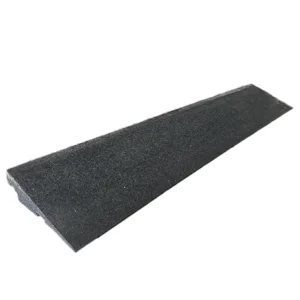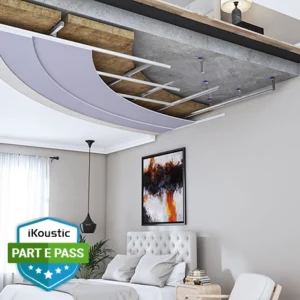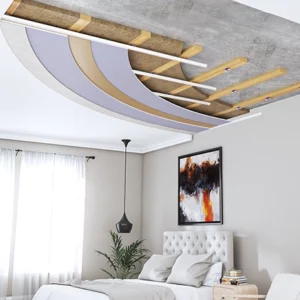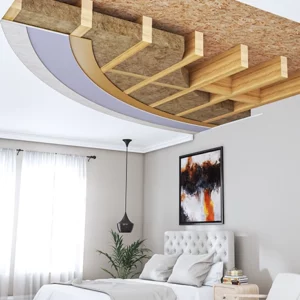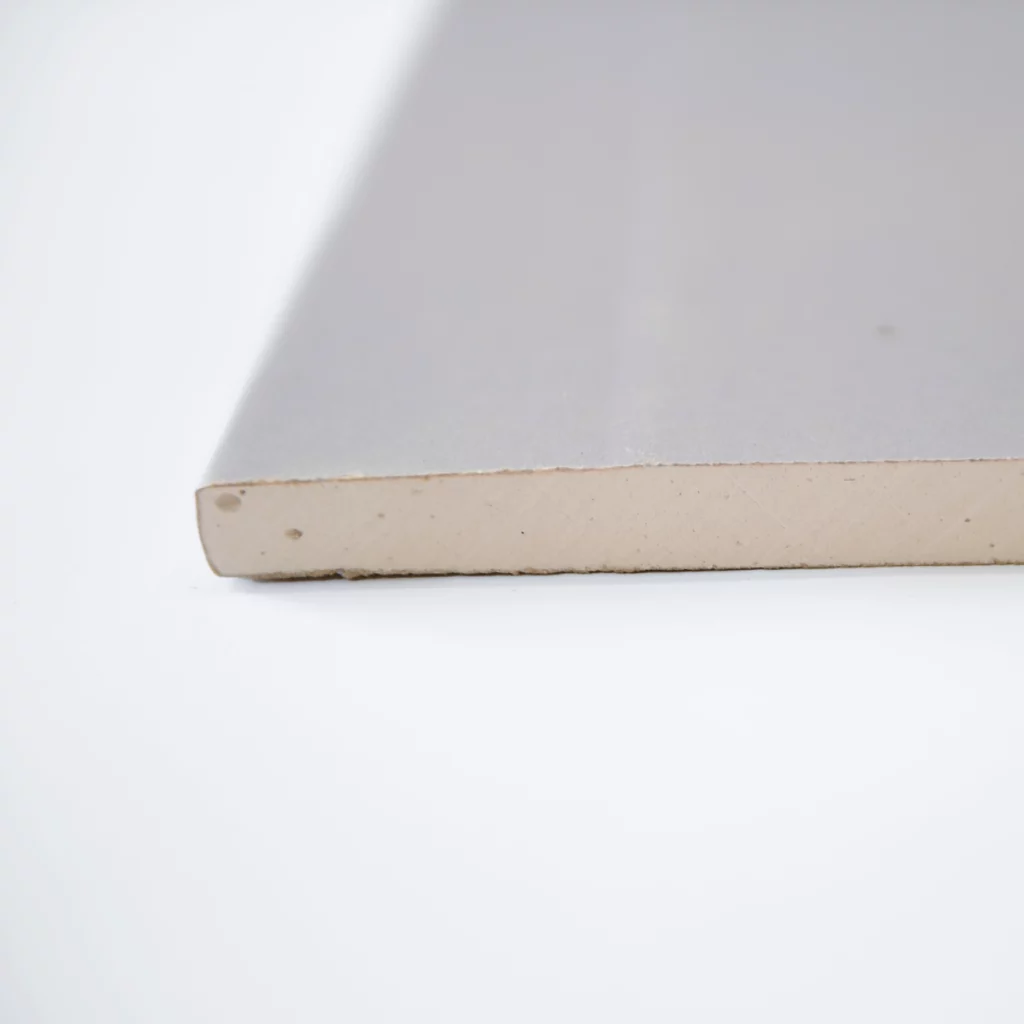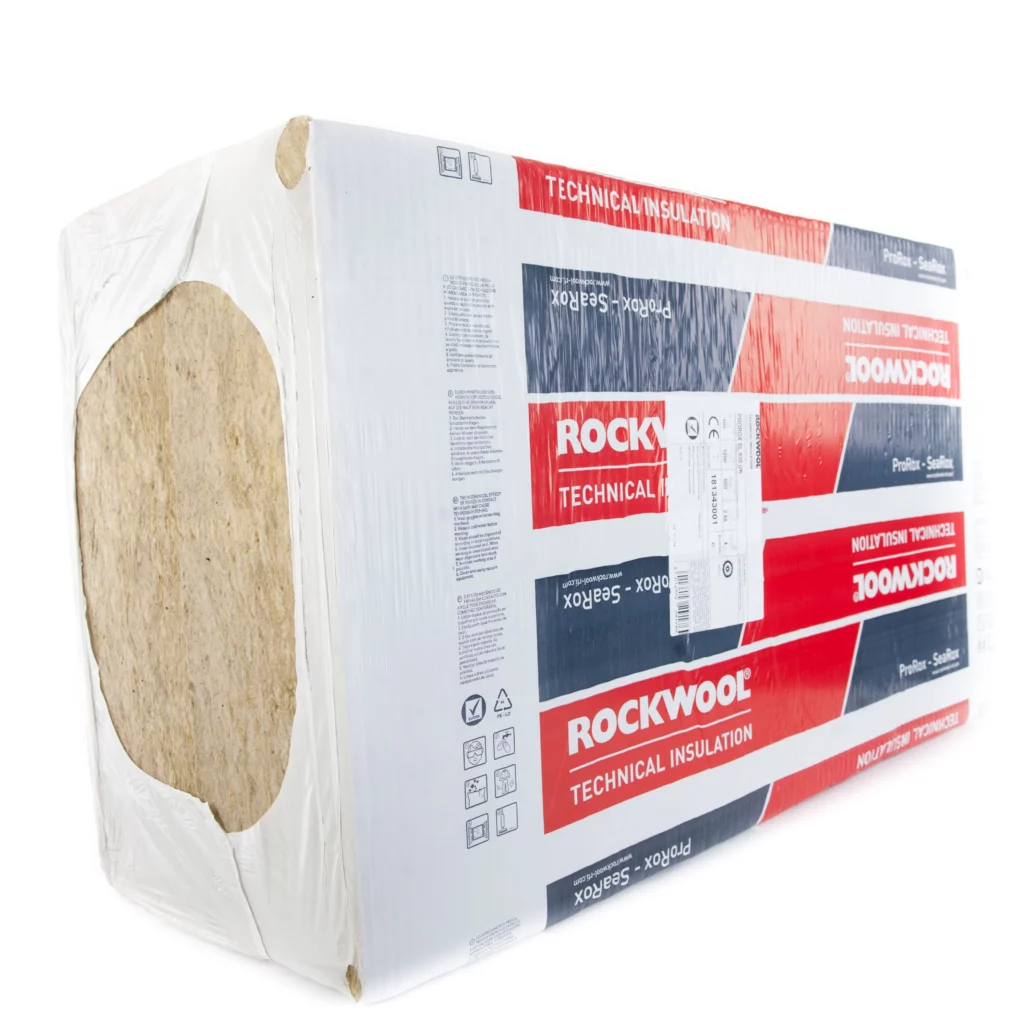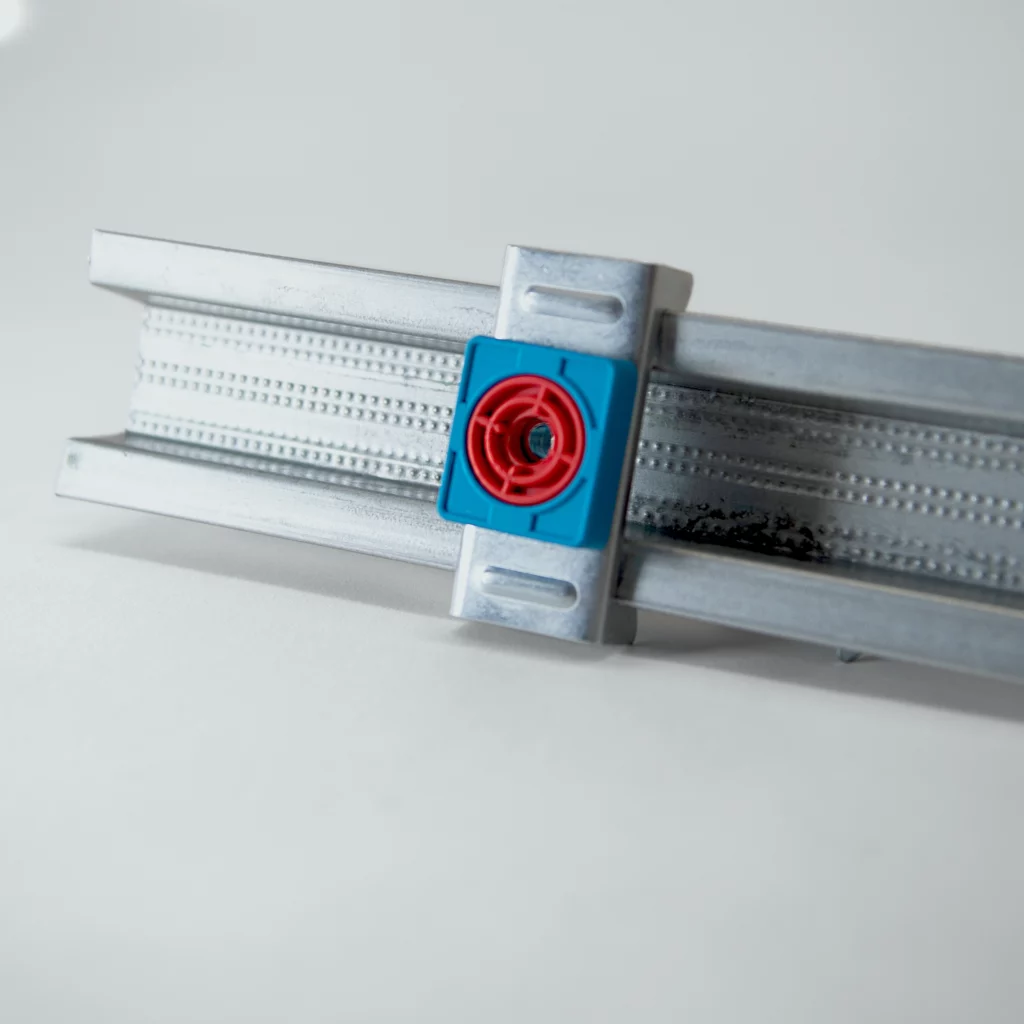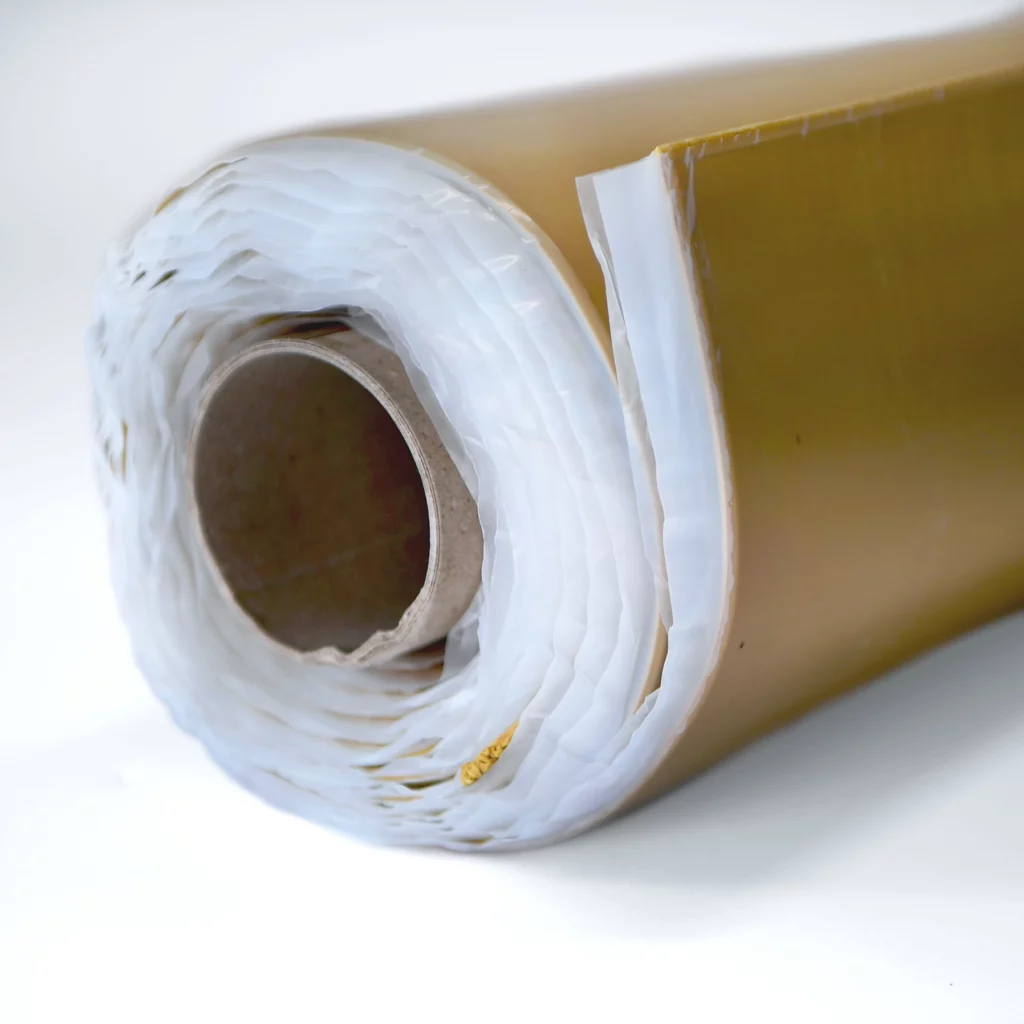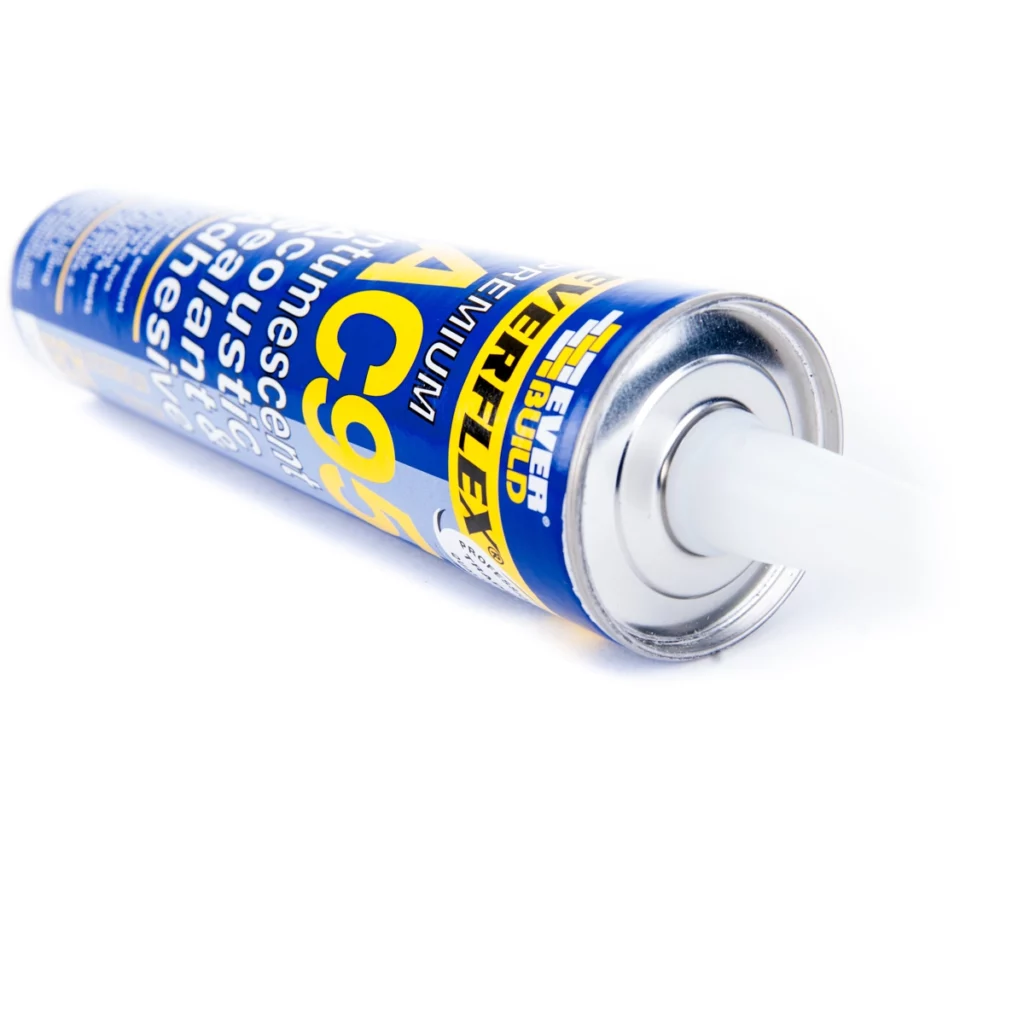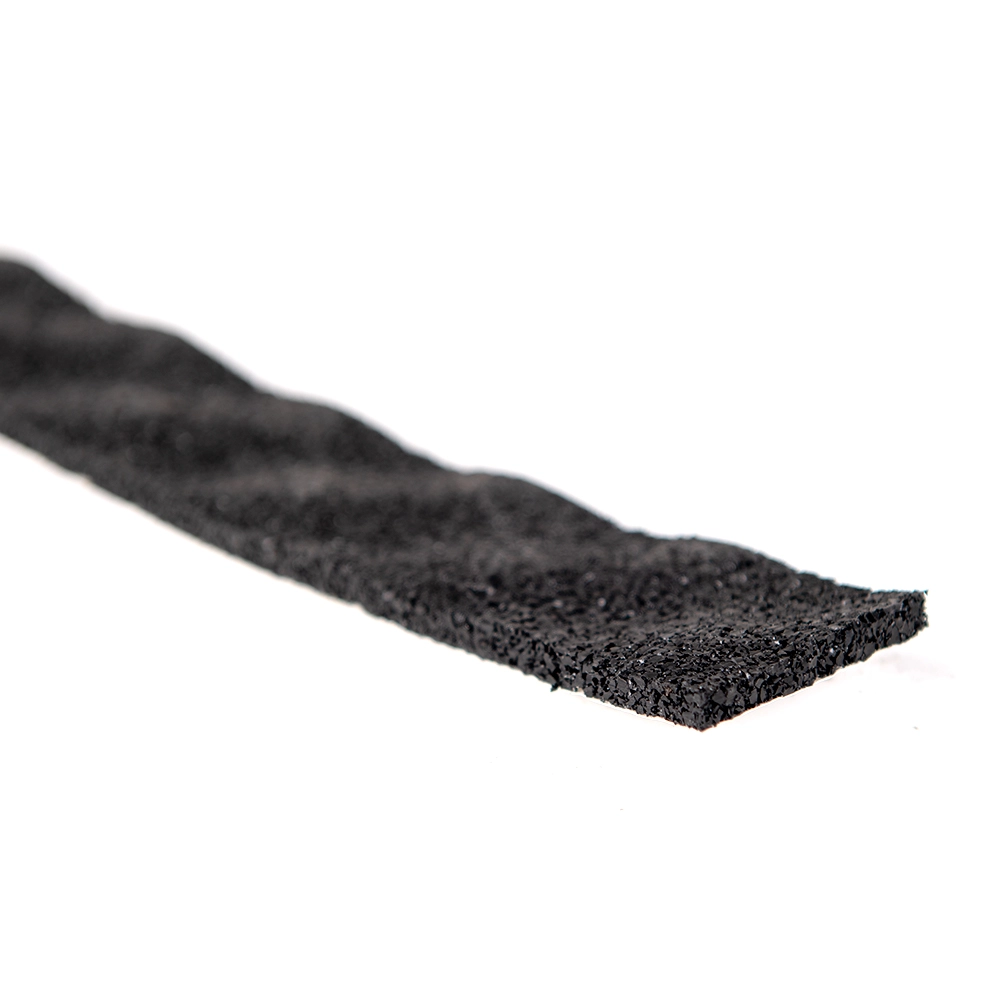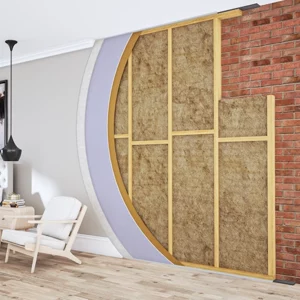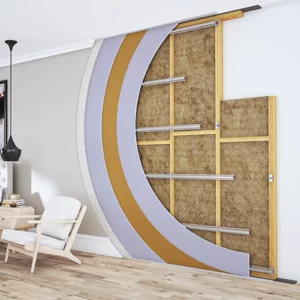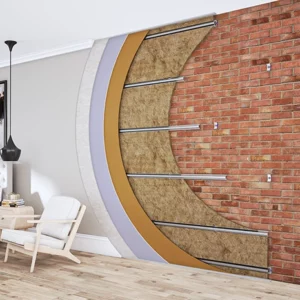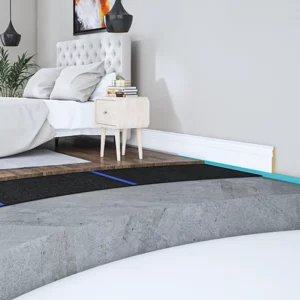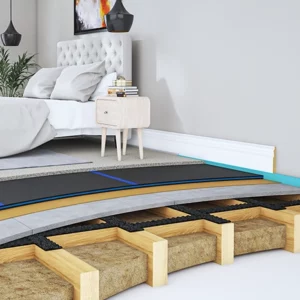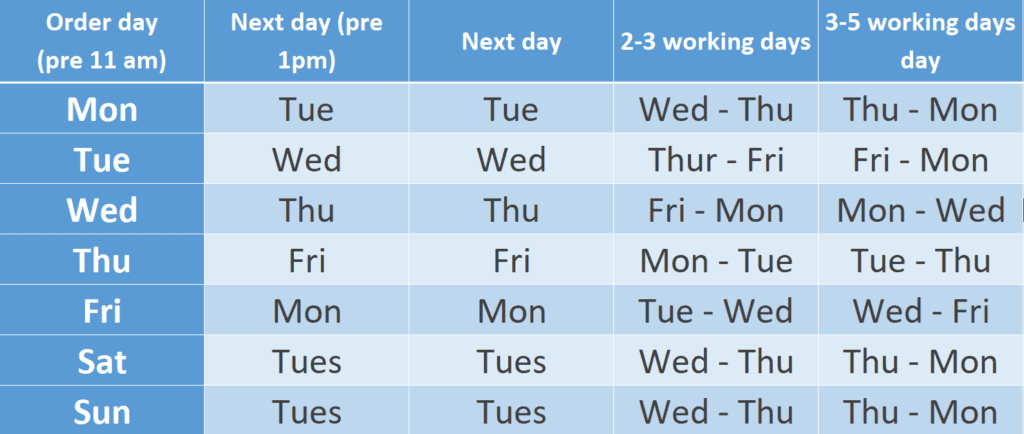Commercial Soundproofing
We offer soundproofing solutions and support for specific requirements from offices to gyms, and have experience with home cinemas and studios.
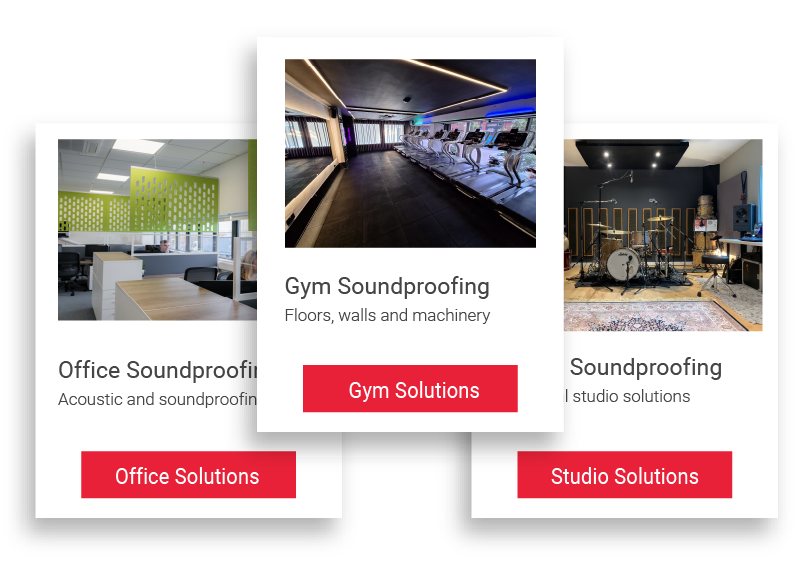
Commercial Soundproofing
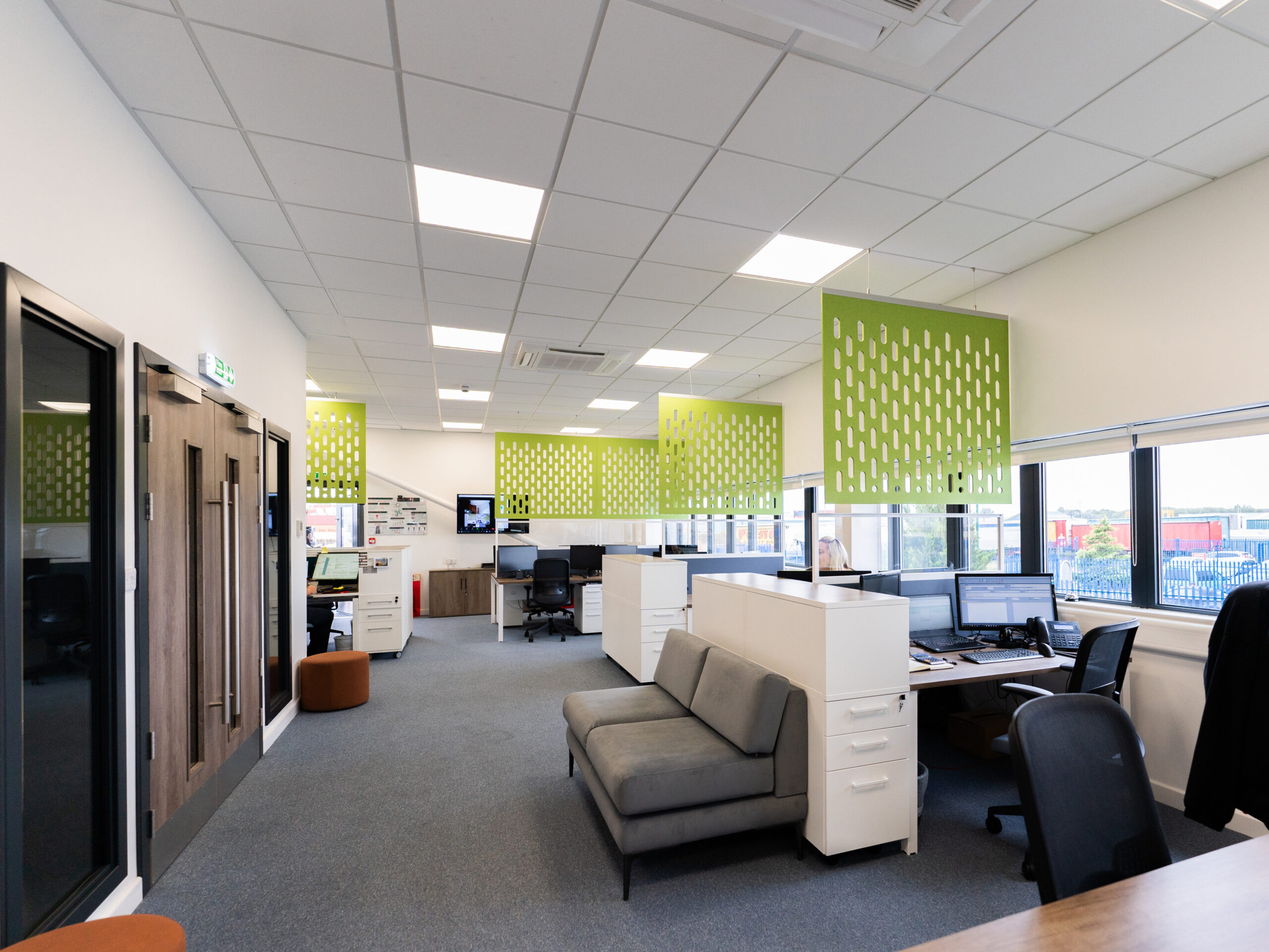
LOOK AT
Office Soundproofing
From budget friendly to top performing floor soundproofing systems, we have it all!
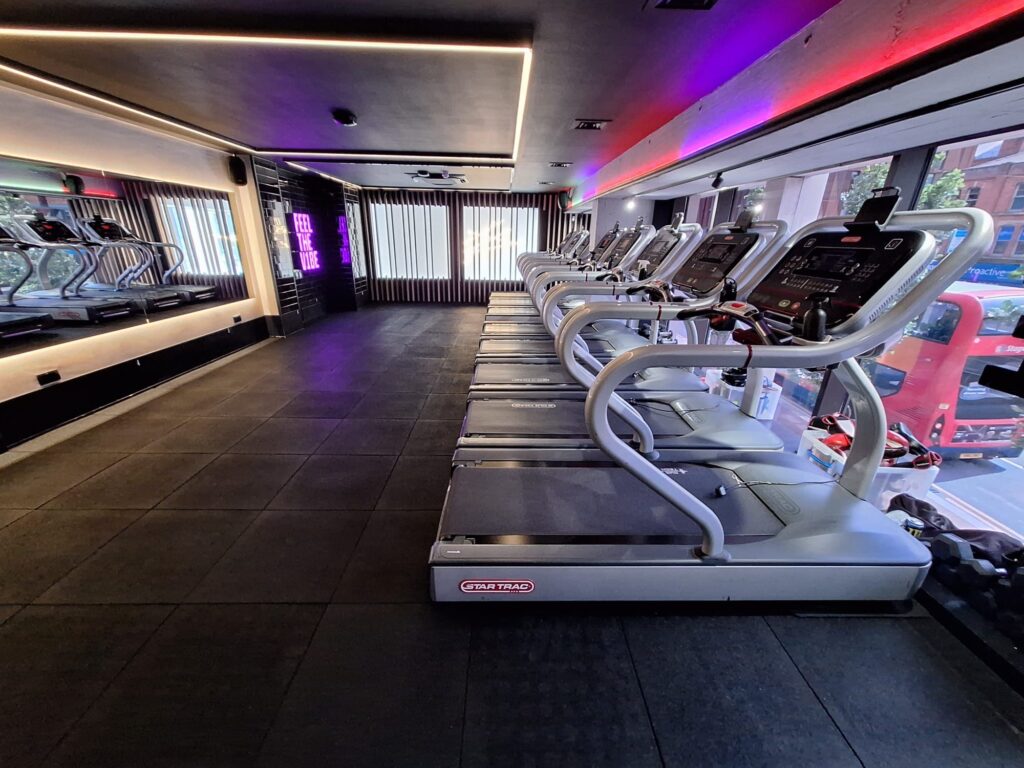
LOOK AT
Gym Soundproofing
Find brick wall, stud wall, party wall and Part-E wall soundproofing systems.
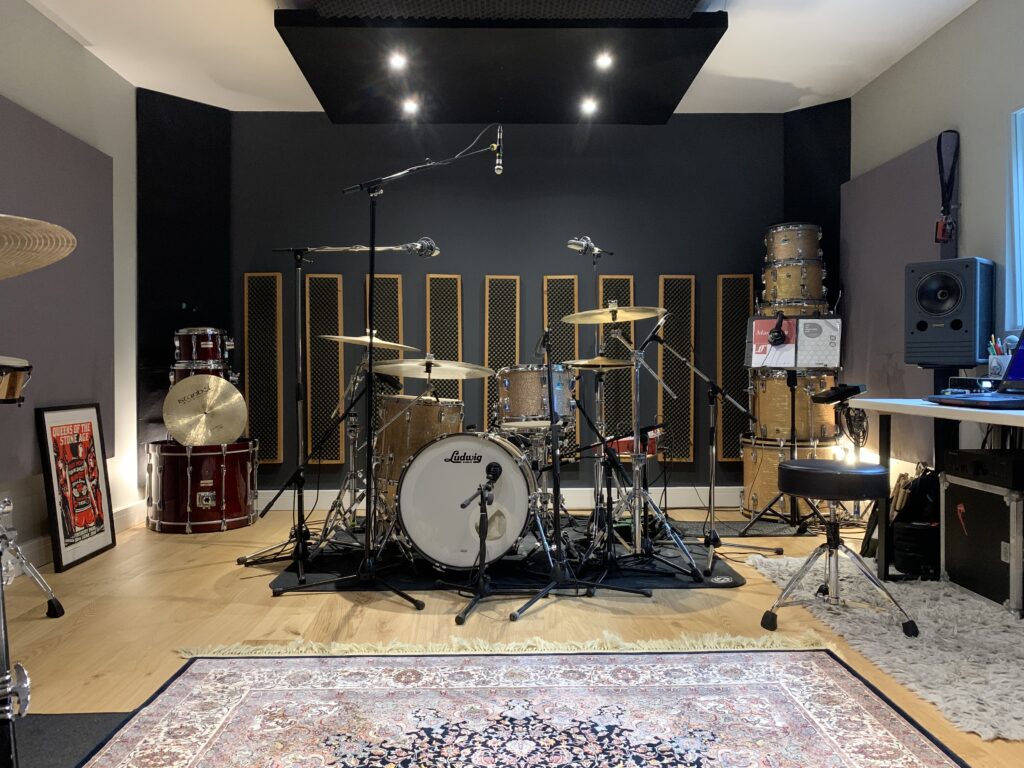
LOOK AT
Niche Soundproofing
We have experience with home cinemas and music studios, see how we can help.

Office Soundproofing
From budget friendly to top performing floor soundproofing systems, we have it all!

Gym Soundproofing
Find brick wall, stud wall, party wall and Part-E wall soundproofing systems.

Niche Soundproofing
We have experience with home cinemas and music studios, see how we can help.
Gym Soundproofing
Our focus on gym soundproofing has increased over the past few years and our offerings have expanded as the rise in well-being for general all-around fitness and wellness has increased. Our inner-city developments are now multi-purpose, meaning that we receive planning proposals for gym soundproofing alongside residences and workplaces, who sometimes also have pieces of gym equipment, and this section is for you too! The management of acoustics and soundproofing for these buildings need great attention, as the design requirements for gyms are high to protect the local community.
Gym Soundproofing
Our focus on gym soundproofing has increased over the past few years and our offerings have expanded as the rise in well-being for general all-around fitness and wellness has increased. Our inner-city developments are now multi-purpose, meaning that we receive planning proposals for gym soundproofing alongside residences and workplaces, who sometimes also have pieces of gym equipment, and this section is for you too! The management of acoustics and soundproofing for these buildings need great attention, as the design requirements for gyms are high to protect the local community.
Gym Floor Soundproofing
Gym Wall Soundproofing
Gym Ceiling Soundproofing
If you are specifying a new Gym then you will need to carry out a ‘Noise Impact Assessment Test‘ and report which can be seen in our Sound Testing section. A great deal of Acoustic Design is needed for both noises travelling out into adjacent properties, travelling into quieter rooms and for managing the quality of sound internally. We cover everything from vast areas of cardiovascular activities to Olympic weightlifting – so whether you’re proposing a new Gym or working to improve or resolve an existing one – we have the gym soundproofing Systems to successfully design these!
To help you understand what the performance means and our additional focus on areas when gathering information for a soundproofing project, viewing more below will expand this for you. These soundproofing gym systems will offer options for those looking at three deciding categories: Performance, Cost and Thickness.
Turn the volume of the video down to match the noise you’re dealing with for the best results. This video is a digitally recreated noise issue that is then decreased artificially. This is designed to give you a more practical understanding of decibel reduction.
It’s best to think of the MuteClip as a mini shock absorber reducing the transfer of noise vibrations from your wall to a new isolated frame. The dual-density silicone backing makes contact with your wall and surrounds the metal bushing to isolate the clip. This ensures your new system is decoupled from the existing structure.
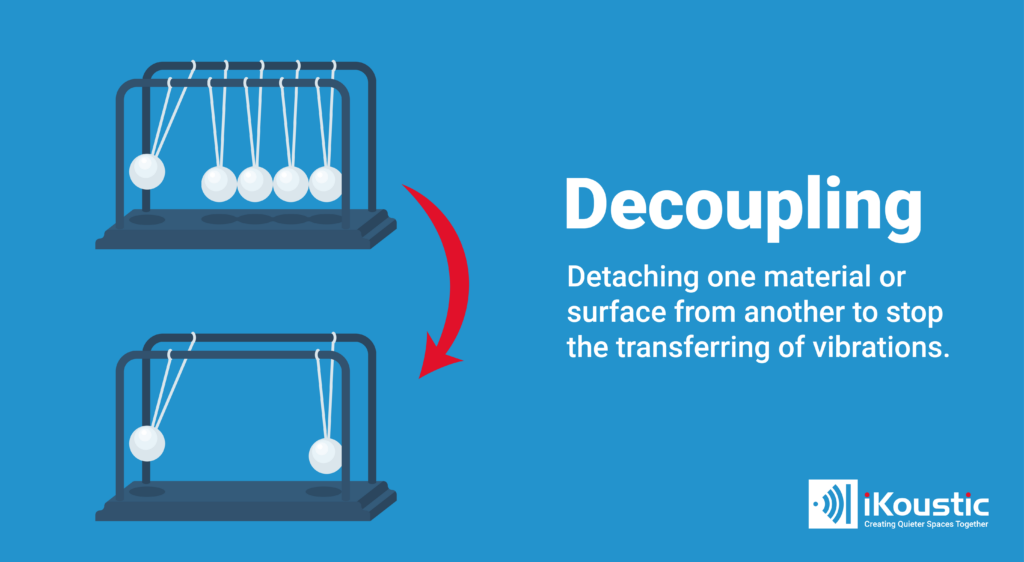
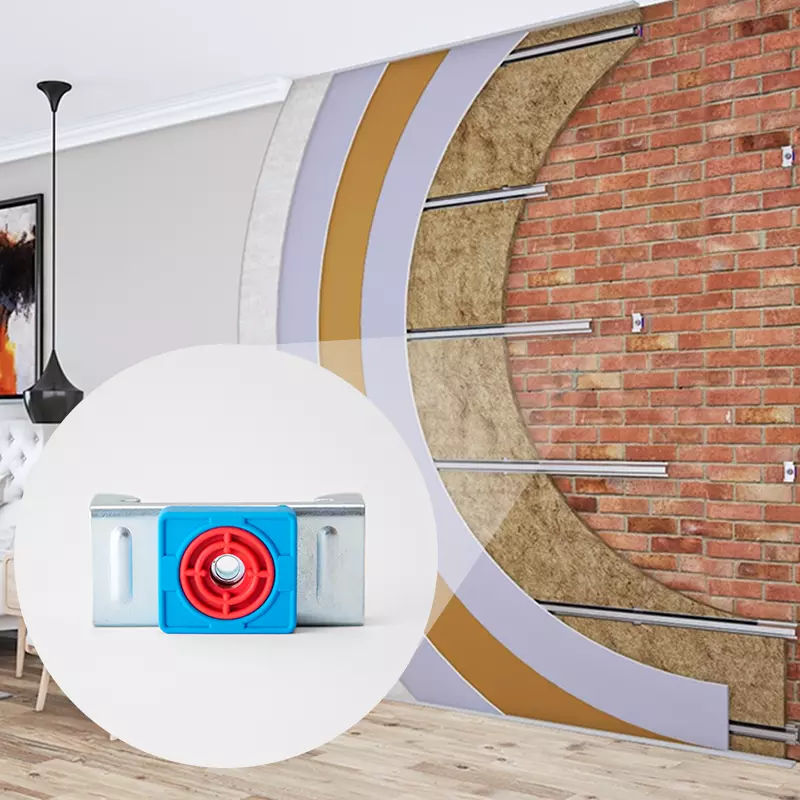
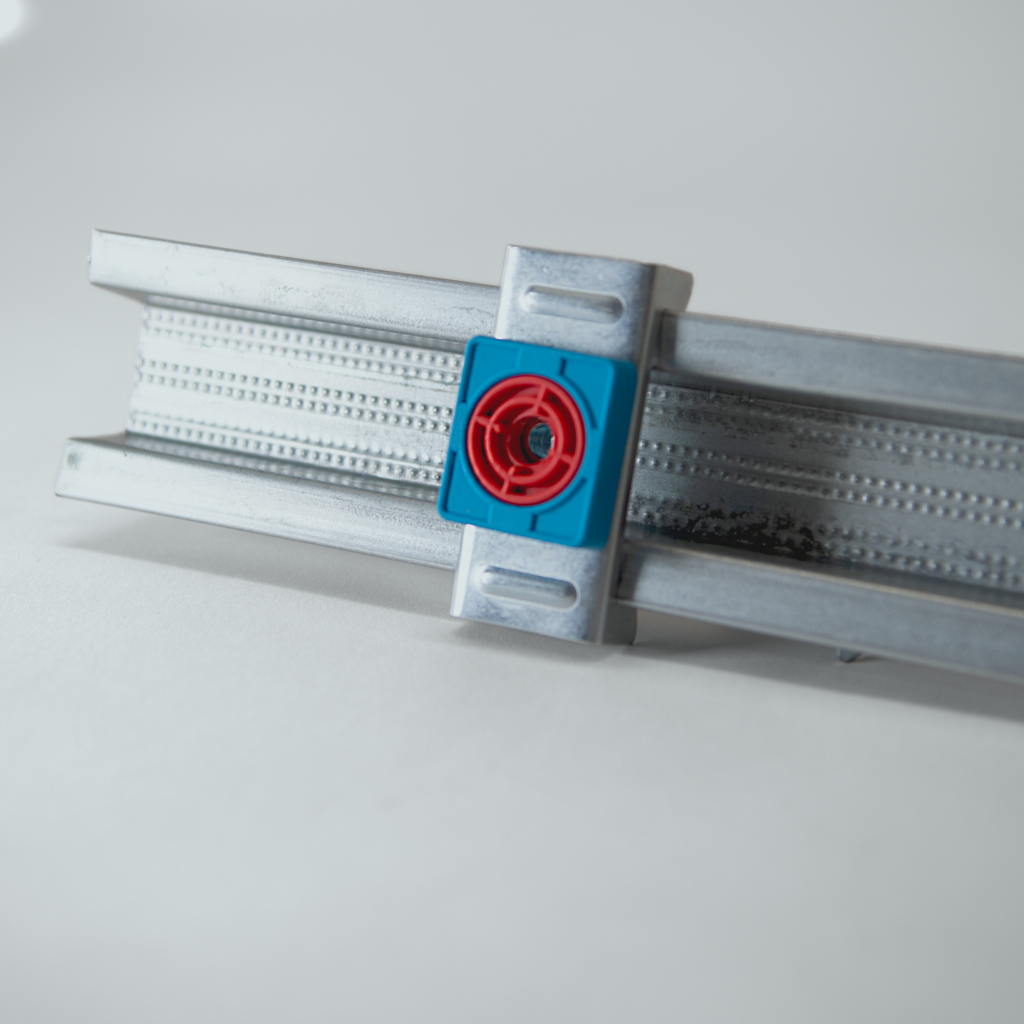
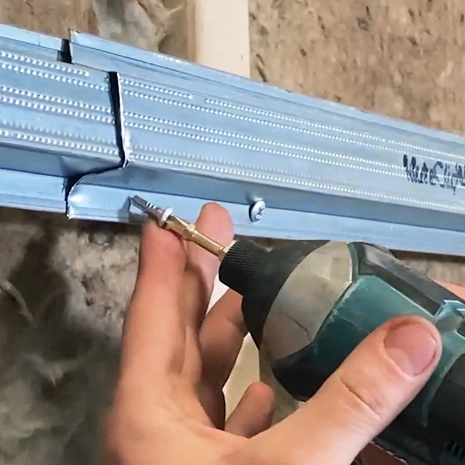
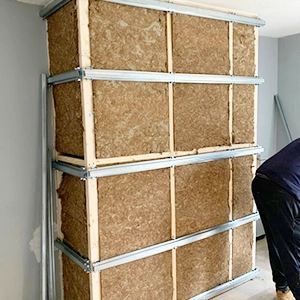
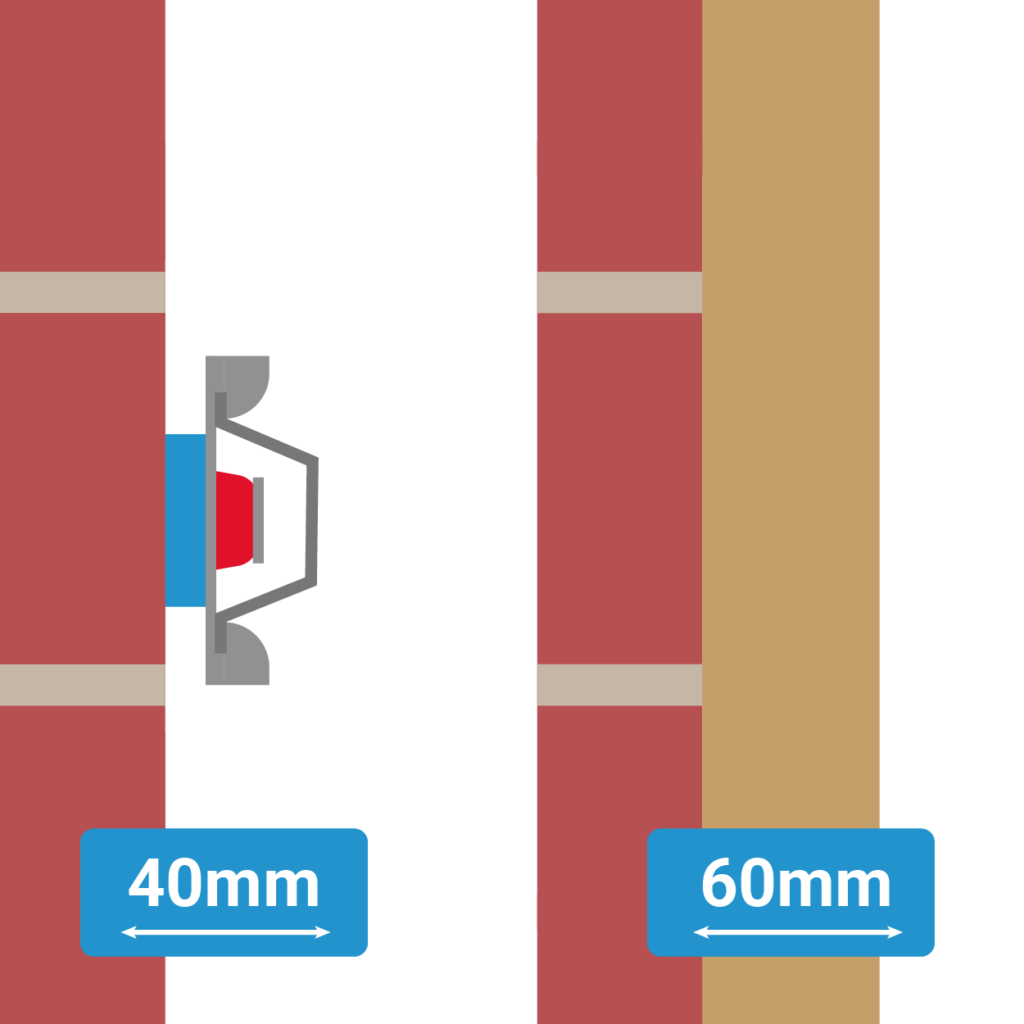

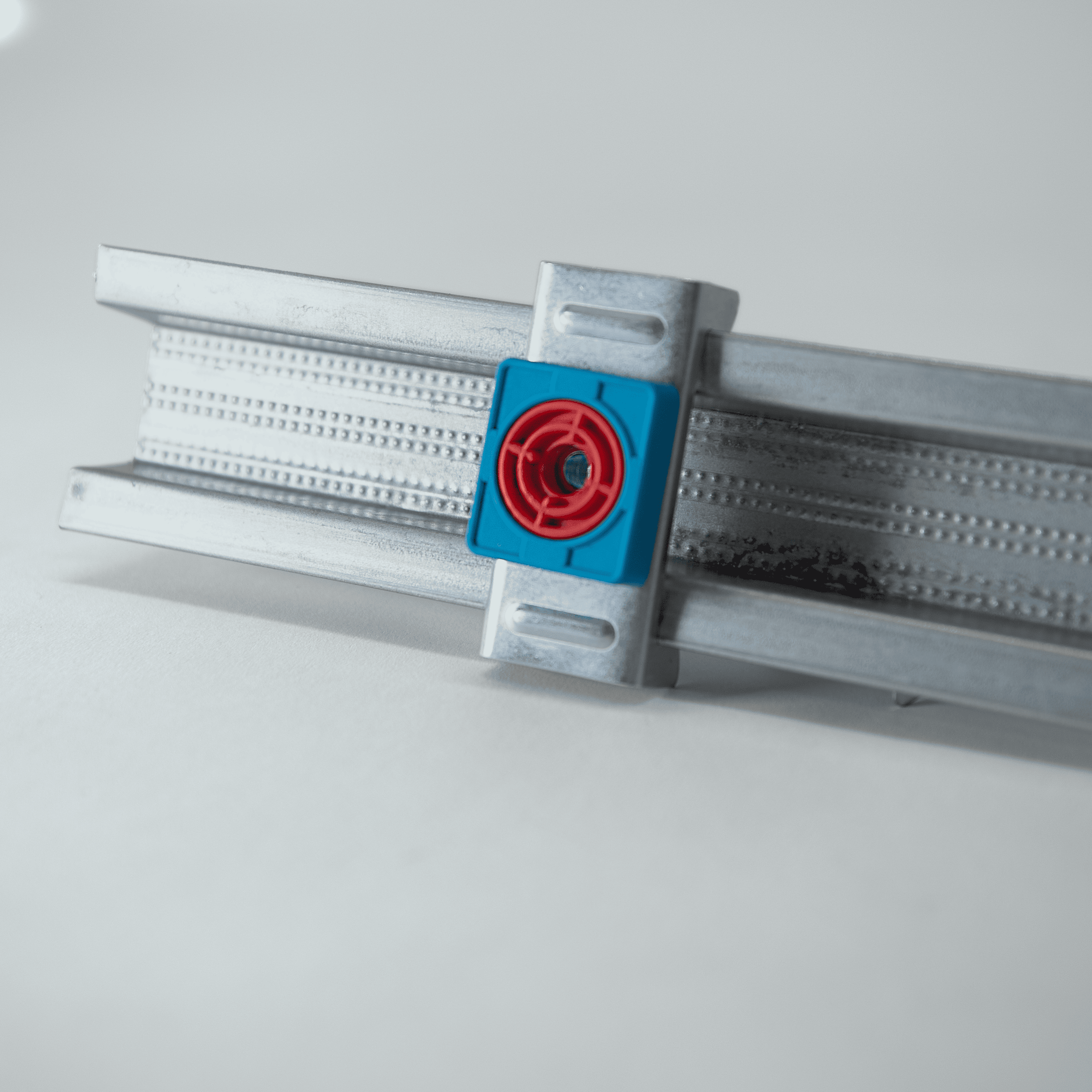


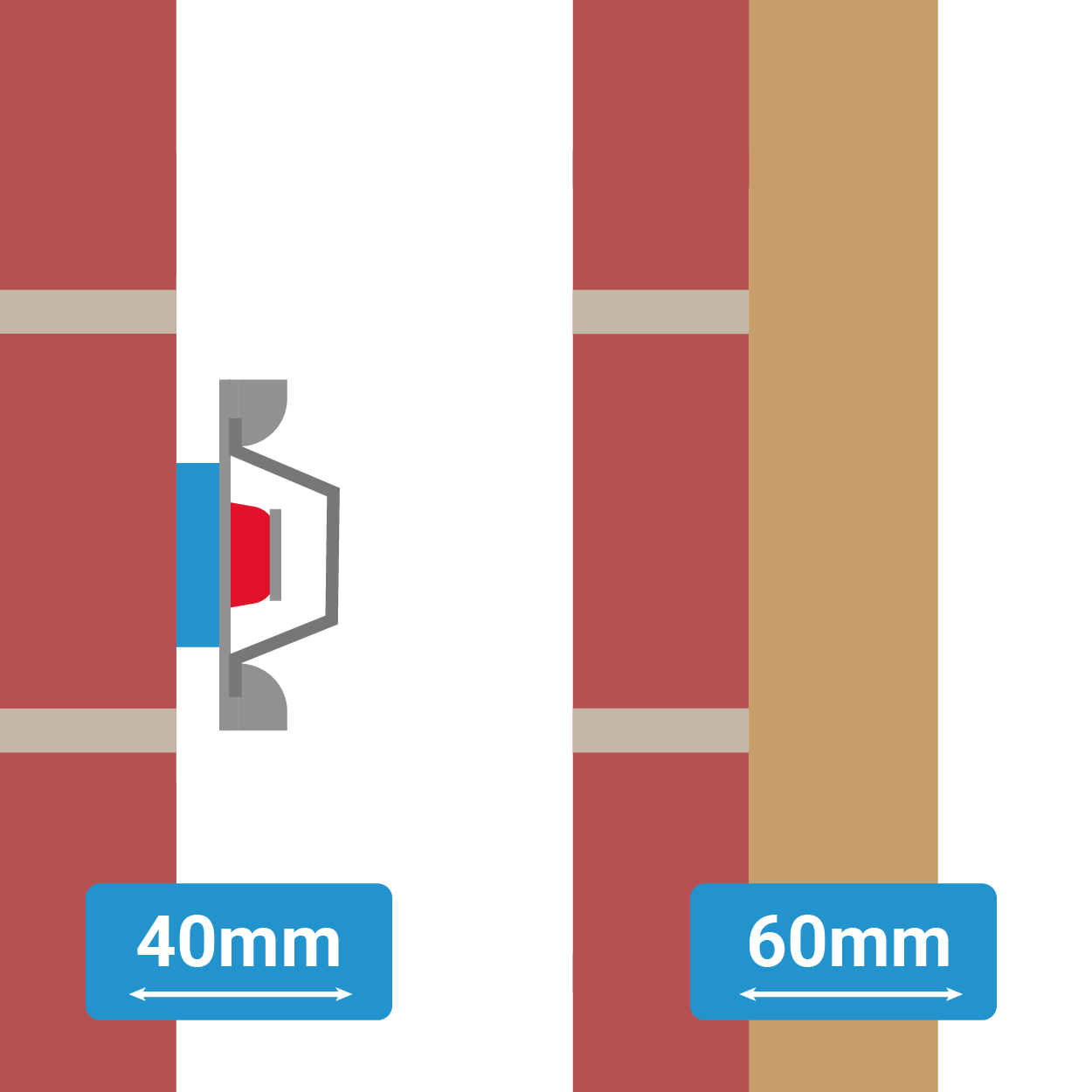
Acoustic Plasterboard
Acoustic plasterboard looks the same as regular sheets, however, it has an increased mass.
What is it for?
Reducing airborne vibrations
How does it work?
The higher mass in acoustic plasterboard allows it to reflect airborne soundwaves and insulate a space.
Where is it used?
Acoustic plasterboard can be used on walls and ceilings. It is often used as the structural base to preformed wall panels.
Acoustic Mineral Wool
Mineral wool that has a minimum density of 45kg/m3 is considered acoustic. It is available in different densities and thicknesses and is a fairly rigid material.
What is it for?
Reduce airborne noise
How does it work?
The open structure allows sound vibration to travel through and the micro-friction created between waves and fibres exhausts the sound into other forms of energy, like heat.
Where is it used?
In any open cavities between joist and stud work.
MuteClips
Isolation clips with dual density silicone that support a metal channel, used to support a new wall or ceiling partition.
What is it for?
Airborne noise
How does it work?
Dual density, vibration damping silicone, wraps the screw butt to prevent direct contact between the wall and the metal supporting channel. This isolates vibrations and is the most effective solution for space used.
Where is it used?
Walls and ceilings
Tecsound
Tecsound is a visco-elastic membrane which comes in different weights and with the option for a self-adhesive back.
What is it for?
Reducing airborne and impact
How does it work?
Tecsound has a very high mass, for reflecting airborne sound waves. The visco-elastic quality allows the material to flex and absorb impact vibrations.
Where is it used?
Tecsound is a versatile membrane used on walls, floors and ceilings.
Acoustic Sealant
As a general rule, a 2-5mm gap should be left around the perimeter of installed soundproof panels. Into this gap, the acoustic sealant is squeezed.
What is it for?
Reducing flanking transmission
How does it work?
By leaving a gap between materials, vibrations cannot pass from one structure to the next. However, an air gap cannot be left either. Acoustic sealant doesn’t set solid and is the perfect, flexible, material to seal the gap.
Where is it used?
Walls and ceilings
Isolation Strips – Rubber Crumb
Isolation strips can be used on top of wooden joists before the floor is fitted and on stud work to act as a barrier between the wall and partition.
What is it for?
Reducing flanking transmission
How does it work?
Made of the same rubber crumb as underlays, this non-resonant rubber reduces the transference of vibrations between flanking structures.
Where is it used?
Tops of floor joists and outside of stud work.
Soundproofing science made simple…
Understanding the decibel scale
Decibels are how we measure sound but due to the logarithmic nature of the Decibel scale, it isn’t the most intuitive concept to grasp. If you are interested in soundproofing the key thing to take away from this article is that reducing sound by 10dB is a perceived halving of the sound you hear. Lets take a look at some examples….
10 dB reduction
20 dB reduction
30 dB reduction
40 dB reduction
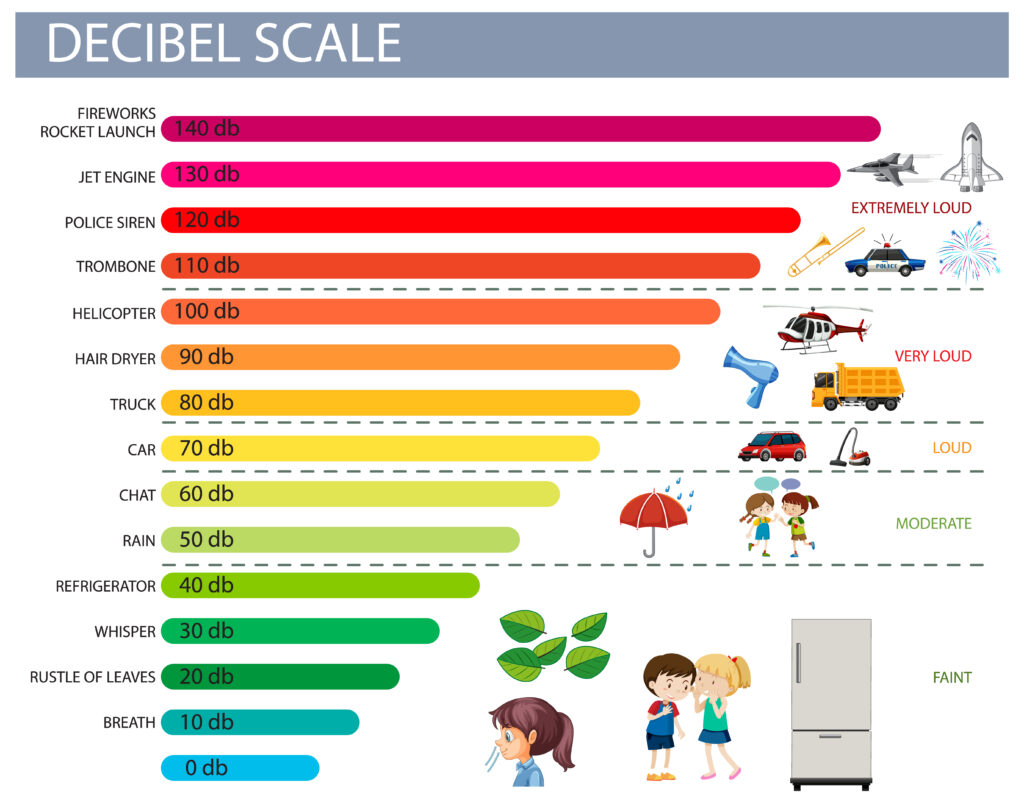
Airborne noise
Sound that uses the medium of air to travel through. Common examples include talking, music and TV.
Impact noise
Sound generated by two materials coming into contact, sound vibrations travel through the materials. Common examples are footsteps and washing machines.
Flanking Transmission
When sound vibrations travel over, under or around a barrier. Flanking transmission can occur when there are holes in walls made by light fixings, shelves or picture hooks. Another common example is pipe work which can vibrate with sound waves and travel between various rooms.
Decoupling
A method of soundproofing which reduces points of direct contact between two surfaces or places a vibration resistant material between them. Common examples are isolation clips (MuteClips), secondary stud walls and isolation strips on stud work.
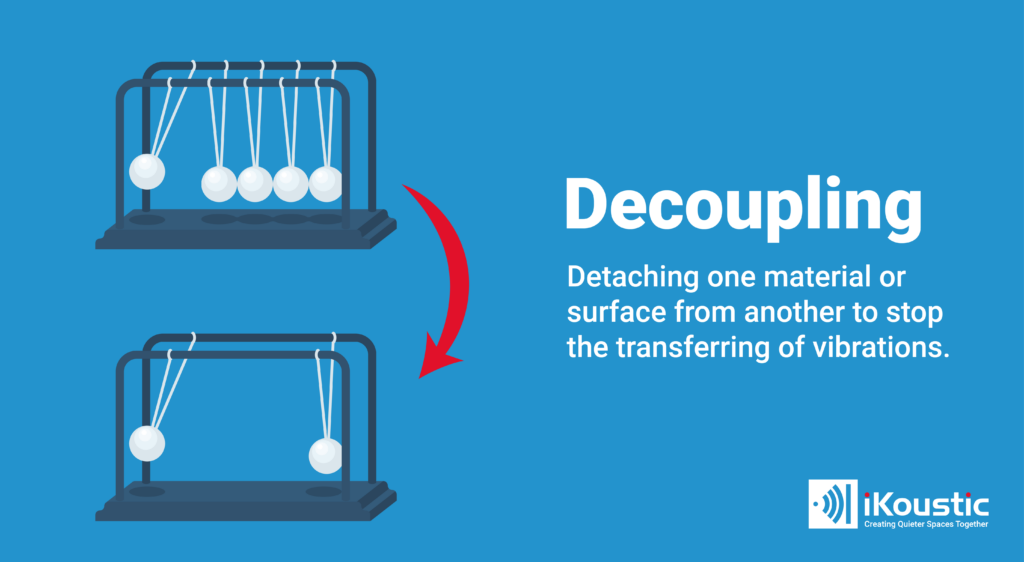
Mass addition
A method of soundproofing that uses materials of high mass to reflect airborne noise within a space. This prevents sound escaping a space or entering a space.
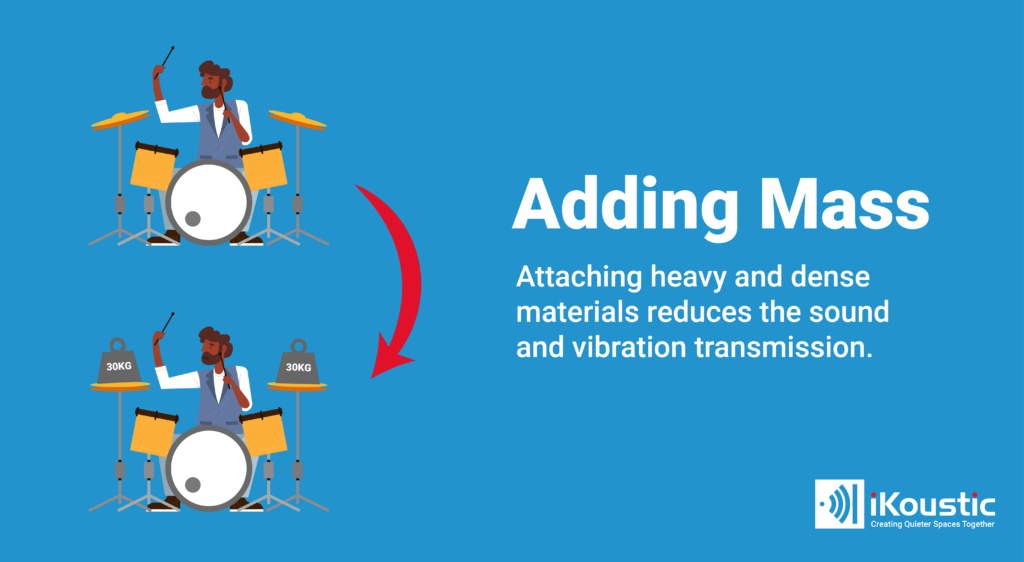
Absorption
A method of sound control which uses materials with open structures, such as foams and loose woven fibres, to damp sound. This reduces the reflection of sound waves within a space which would lead to reverberation and the amplification of sound.
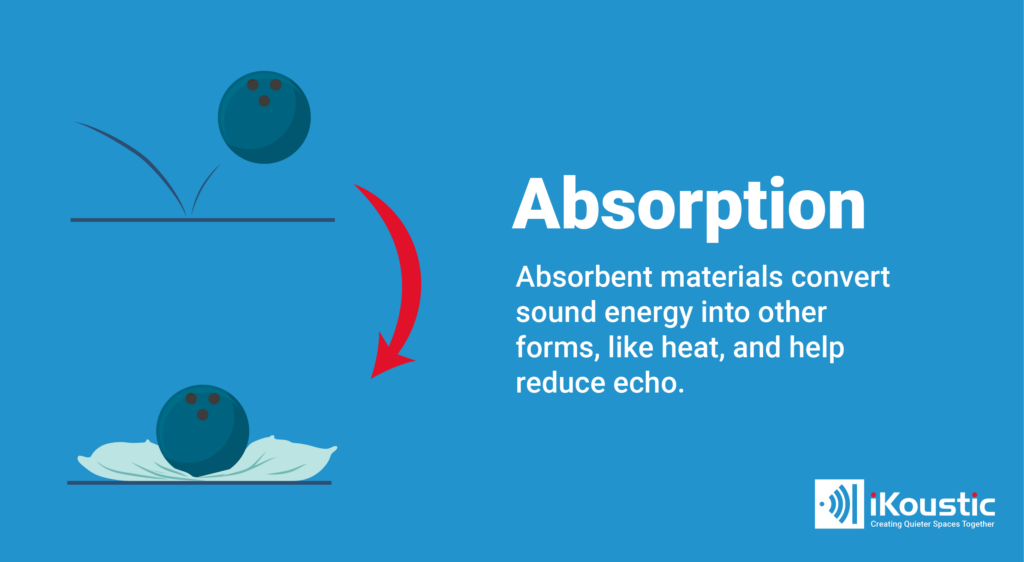
How to reduce impact noise
To reduce impact noise, which uses the structure to travel through, an ideal solution is to decouple surfaces wherever possible. This will reduce the points of contact where vibrations are able to pass from one structure into the next.
An example of this could be a ‘floating floor’ which would make contact with the ceiling below in fewer places and reduce the volume of footsteps. Alternatively, stud walls can be rested on isolation strips which will reduce the amount of vibrations that can travel from the floor into the walls.
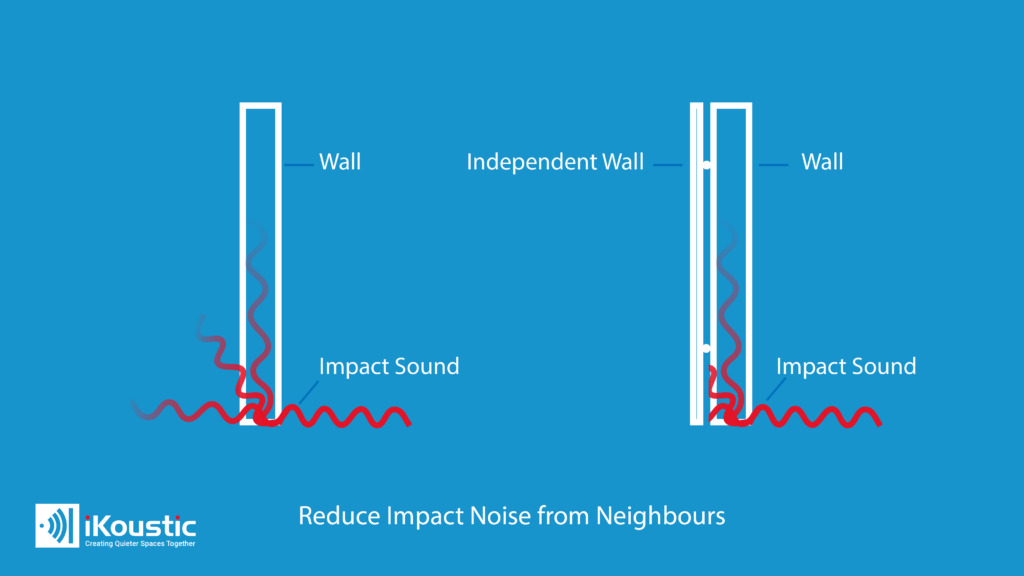
How to reduce airborne noise
Airborne noise is reduced by using materials of high mass to insulate a space. Because sound vibrations in the air don’t carry enough energy pass through high mass materials, they are instead reflected away. This helps to keep sound inside a space and prevent sound entering the space, too.
Materials of high mass can be added to walls, ceilings and floors and are often used to reduce ‘noisy neighbour’ disturbances.
How to reduce flanking transmission
Flanking transmission can be reduced in a multitude of ways but first and foremost the weaknesses need to be identified. These could be fixings for lights, pipe work or screws in walls. Any unavoidable weaknesses, such as pipes, can be treated as individual problems.
For example, there is soundproofing pipe wrap that can be installed to help isolate the system. For light fixings, there are sound control caps that can be fitted and likewise for electric sockets. When screws and nails are fixed to walls, it’s best to avoid drilling them further than necessary.
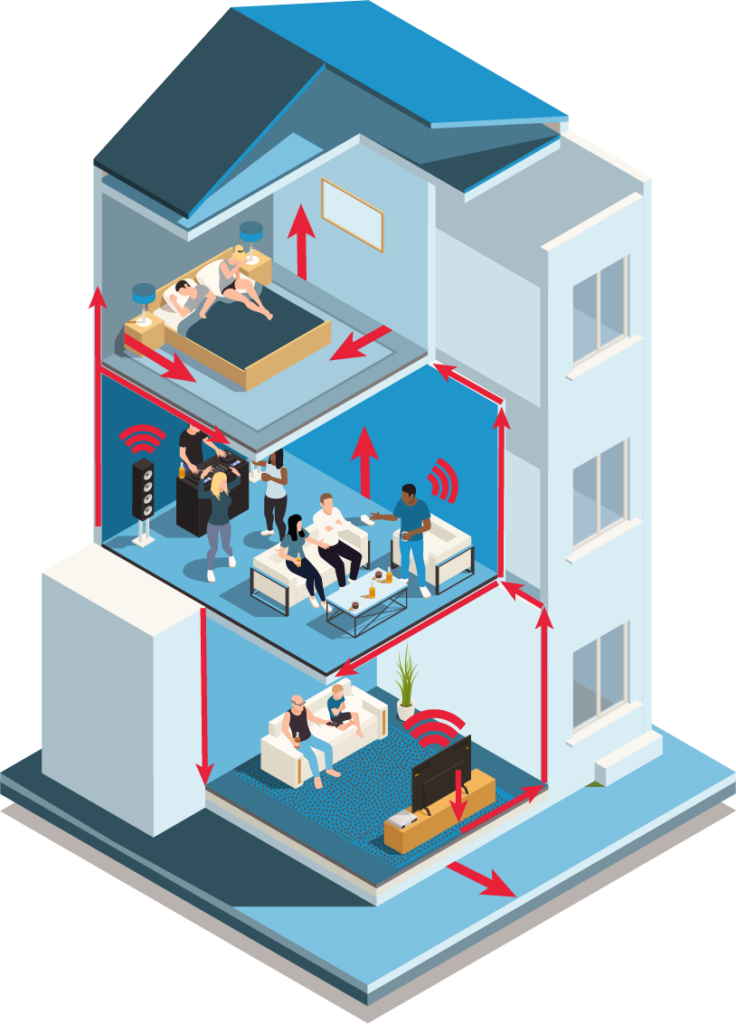
Conclusions
So that’s our whistle-stop tour of the soundproofing world, obviously this only scrapes the surface. If you want to learn more check out our blogs or YouTube channel.
Yes, you can install our soundproofing yourself if you don’t want to hire a soundproofing installer. We recommend that you’re a confident DIYer with some experience of hand tools and check to make sure you have the appropriate equipment before starting.
Installation Guides
Installation guides are available to download as a PDF from system and product pages. In these guides, you’ll find the tools required, the method for installation and some helpful diagrams. Please take a read of these before committing to a DIY install.
Installation Videos
We also have a range of installation videos to help you, these can be found on our YouTube channel.
Contact Us
If you need any extra advice when it comes to installing your wall soundproofing then you can also get in touch with us.
Yes, we have a UK wide network of soundproofing installers who are on hand to give you a quote for your project. If you’d like to receive a quote for an installer or hire a soundproofing installer then fill out the form below. Be sure to provide as much information as possible for an accurate quote and the best advice on materials.
Yes, you can soundproof around a variety of awkward areas in your room from RSJs to alcoves, chimneys, boxed piping and electric sockets. Find out how to do this for each area by clicking the options.
How to Soundproof an alcove
Alcoves can be soundproofed with the same materials that are used for regular walls. Alcoves should be approached methodically and it is good to plan your install before starting. The back wall should be treated first, with the usual 2-5mm gap around the perimeter of acoustic boards. This ensures that flanking transmission is reduced and resultant gaps can be filled with acoustic sealant.
As the diagram illustrates, the additional walls can be treated in synchrony, ensuring that the correct overlap is created at corners. Once again, the acoustic boards should not make contact at corners and gaps created can be filled with acoustic sealant.
Depending on your available space and the severity of your noise complaint, the full MuteClip double system can be used to great effect. If you have a smaller space, slimline alternatives can be installed instead. To get more advice about which system is best for your room, contact our technical team.
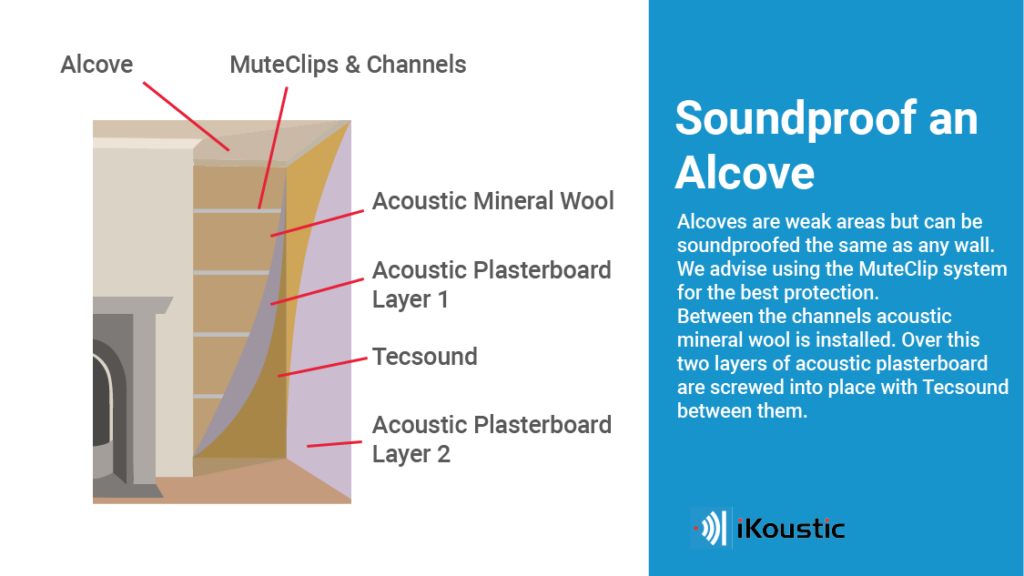
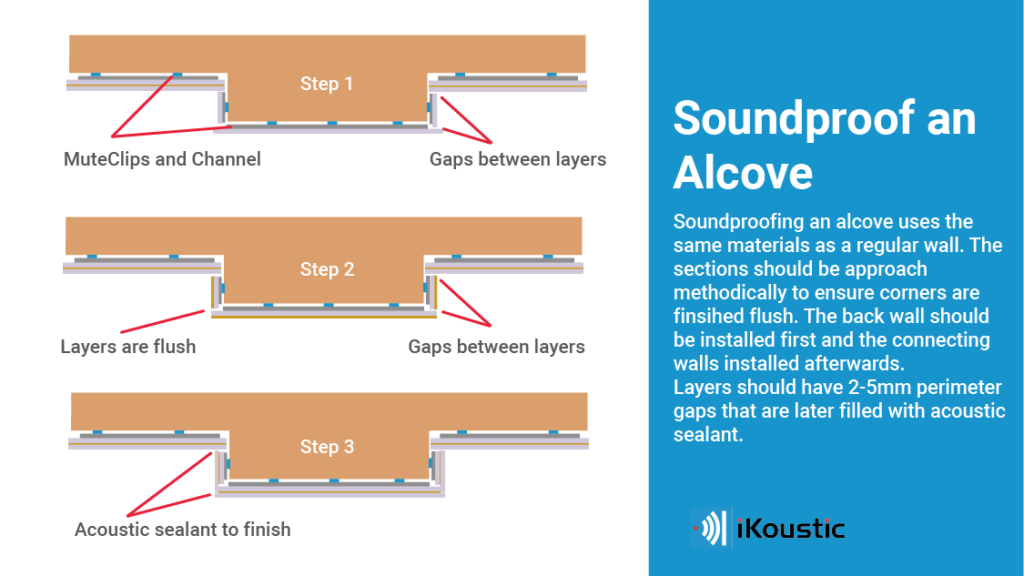
RSJ Soundproofing System
As an RSJ is made from steel, a rigid material, it can conduct sound vibrations through your building. We used a multifaceted approach to treat this issue which inhibits sound traveling along the RSJ and radiating out into your room.
To dampen vibrations traveling along the metal, a layer of self adhesive Tecsound can be used to cover the metal joist. This has impressive vibration dampening qualities thanks to its elastic makeup.
Around this, acoustic mineral wool is packed to reduce reverberation in cavities and isolate the structure from the final layer which is acoustic plasterboard. Acoustic plasterboard has more mass than regular plasterboard and provides resistance to airborne noise.
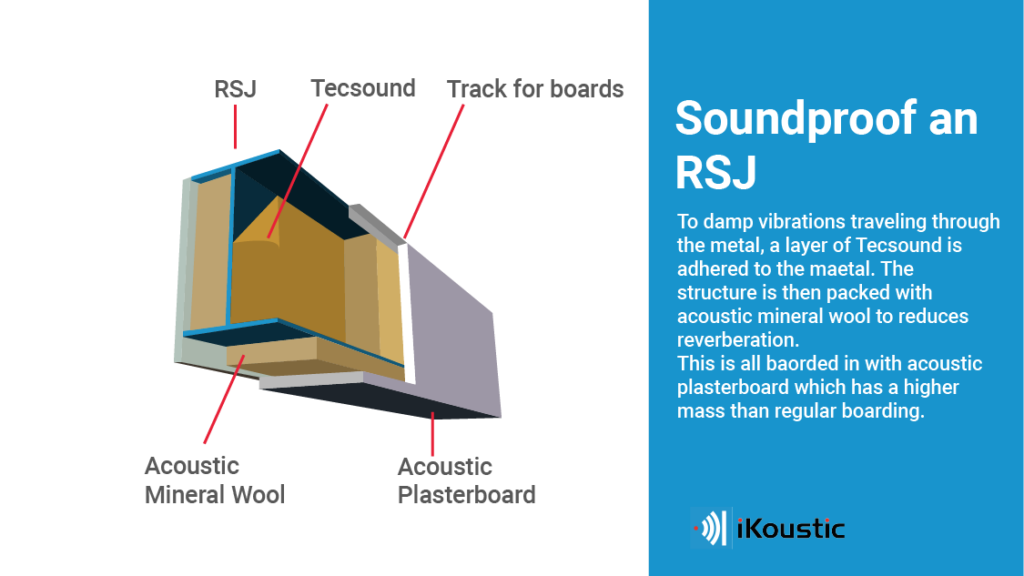
How to soundproof a pipe
Noise from your plumbing, like downpipes can be easily fixed with one material. Tecsound F55 AL uses three different soundproofing materials in one self-adhesive pipe wrap.
The inner layer of aluminum is self-adhesive and wraps around your problem pipe. The middle layer is a vibration dampening membrane of Tecsound, which is visco-elastic. This reduces the transmission of vibrations along the pipe.
A final layer helps absorb noises that try to radiate out of the pipe. The acoustic felt has an open structure that traps soundwaves and reduces reverberation.
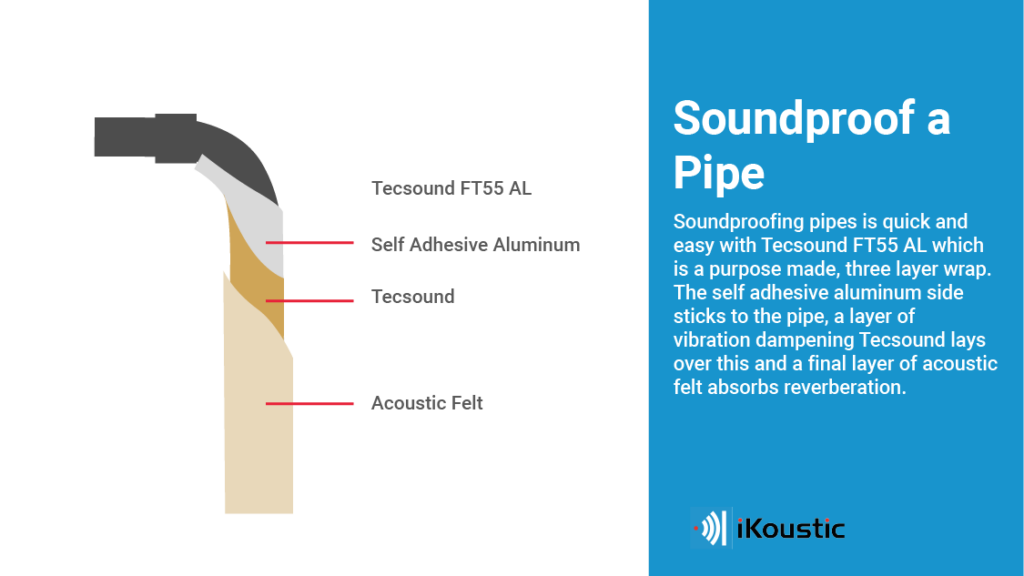
How to soundproof a socket
Sockets are naturally weak areas of walls as the air gap can easily transmit airborne noises like talking and music. To improve the sound resistance of sockets, an acoustic insert can be placed behind the facing. This creates a barrier to airborne noises and improves the overall performance of your wall by reducing flanking transmission.
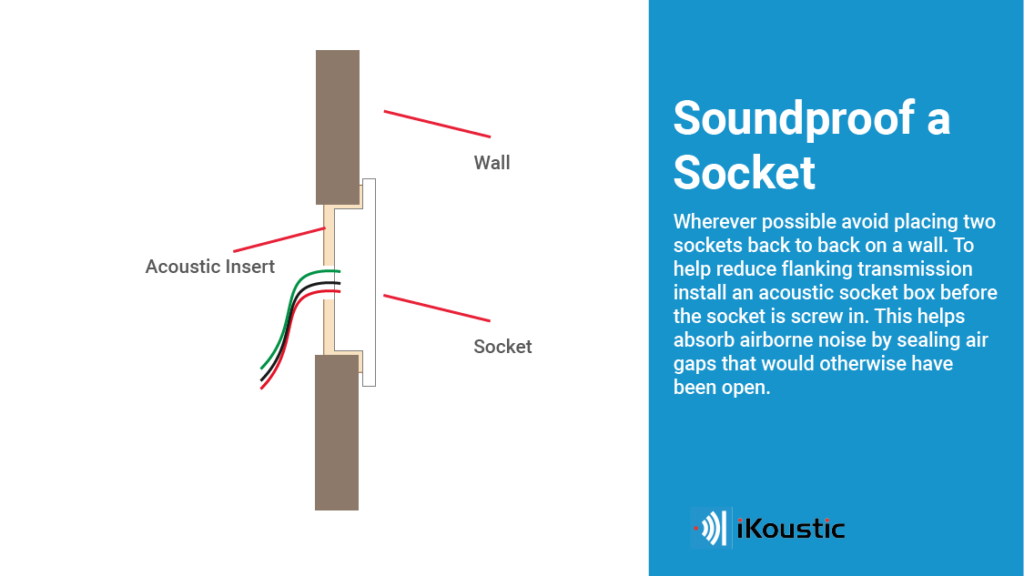
We calculate our decibel reductions by measuring the difference a system has made. This doesn’t include the pre-existing resistance of the wall, floor or ceiling.
For example, if we have a reduction figure of 17dB for a wall system, it’s showing the improvement made to the existing wall. Brick walls already have a resistance of around 40dB and most sites show this figure in addition to the improvement figure of 17dB. This is why some sites show systems which achieve a reduction of over 50dB; it’s the resistance of the existing wall and their system.
As every wall will resist sound differently, and the tested wall may have an especially high resistance to sound to begin with, we prefer to show the improvement figure achieved by a soundproofing system. This makes it easier for you to compare our systems and get a realistic idea of how much noise each soundproofing system will resist.
If you have any questions about data, how to read it or which soundproofing intervention you need, please get in touch with our team who will be happy to help.
dB: Decibel, which is used to measure the level of sound.
dBA: A-weighted decibels, these take into account human sensitivity to different frequencies of sound.
ΔdB: Delta decibels, which represent the change in sound level before and after the soundproofing intervention.
ΔLlin (Delta L-linear): This represents the change in sound levels on a linear scale. For example if the baseline noise level is 60dB and after soundproofing it had reduced to 50dB the ΔLlin would be 10dB.
ΔLw (Delta L-weighted): Arguably more important than the former, this represents the change in dB after soundproofing using the A-weighted scale. This therefor takes into account the human perception of sound reduction by emphasising the frequencies which the human ear is most sensitive to and de-emphasising others. In essence, ΔLw provides a more meaningful measurement of sound reduction.
Resistance to fire for our most popular system materials. Euroclass ‘A-F’ rating is for the ability of the material to catch fire, A1 and A2 rates the material as non-combustible. The ‘S’ rating, (1-3), is for the severity of smoke with s1 being the lowest. Lastly the ‘d’ rating is for droplets, d0 meaning no droplets.
Acoustic Plasterboard: Euroclass A2-s1, d0
60kg/m3 Acoustic Mineral Wool: Euroclass A1
100kg/m3 Acoustic Mineral Wool: Euroclass A1
Tecsound SY50: EN 13501-1:B-s2,d0
Tecsound SY70: EN 13501-1:B-s2,d0
Tecsound SY50 ALU: EN 13501-1:B-s2,d0
Gym Floor Soundproofing
Gym Wall Soundproofing
Gym Ceiling Soundproofing
If you are specifying a new Gym then you will need to carry out a ‘Noise Impact Assessment Test‘ and report which can be seen in our Sound Testing section. A great deal of Acoustic Design is needed for both noises travelling out into adjacent properties, travelling into quieter rooms and for managing the quality of sound internally. We cover everything from vast areas of cardiovascular activities to Olympic weightlifting – so whether you’re proposing a new Gym or working to improve or resolve an existing one – we have the gym soundproofing Systems to successfully design these!
To help you understand what the performance means and our additional focus on areas when gathering information for a soundproofing project, viewing more below will expand this for you. These soundproofing gym systems will offer options for those looking at three deciding categories: Performance, Cost and Thickness.
Turn the volume of the video down to match the noise you’re dealing with for the best results. This video is a digitally recreated noise issue that is then decreased artificially. This is designed to give you a more practical understanding of decibel reduction.
It’s best to think of the MuteClip as a mini shock absorber reducing the transfer of noise vibrations from your wall to a new isolated frame. The dual-density silicone backing makes contact with your wall and surrounds the metal bushing to isolate the clip. This ensures your new system is decoupled from the existing structure.











Acoustic Plasterboard
Acoustic plasterboard looks the same as regular sheets, however, it has an increased mass.
What is it for?
Reducing airborne vibrations
How does it work?
The higher mass in acoustic plasterboard allows it to reflect airborne soundwaves and insulate a space.
Where is it used?
Acoustic plasterboard can be used on walls and ceilings. It is often used as the structural base to preformed wall panels.
Acoustic Mineral Wool
Mineral wool that has a minimum density of 45kg/m3 is considered acoustic. It is available in different densities and thicknesses and is a fairly rigid material.
What is it for?
Reduce airborne noise
How does it work?
The open structure allows sound vibration to travel through and the micro-friction created between waves and fibres exhausts the sound into other forms of energy, like heat.
Where is it used?
In any open cavities between joist and stud work.
MuteClips
Isolation clips with dual density silicone that support a metal channel, used to support a new wall or ceiling partition.
What is it for?
Airborne noise
How does it work?
Dual density, vibration damping silicone, wraps the screw butt to prevent direct contact between the wall and the metal supporting channel. This isolates vibrations and is the most effective solution for space used.
Where is it used?
Walls and ceilings
Tecsound
Tecsound is a visco-elastic membrane which comes in different weights and with the option for a self-adhesive back.
What is it for?
Reducing airborne and impact
How does it work?
Tecsound has a very high mass, for reflecting airborne sound waves. The visco-elastic quality allows the material to flex and absorb impact vibrations.
Where is it used?
Tecsound is a versatile membrane used on walls, floors and ceilings.
Acoustic Sealant
As a general rule, a 2-5mm gap should be left around the perimeter of installed soundproof panels. Into this gap, the acoustic sealant is squeezed.
What is it for?
Reducing flanking transmission
How does it work?
By leaving a gap between materials, vibrations cannot pass from one structure to the next. However, an air gap cannot be left either. Acoustic sealant doesn’t set solid and is the perfect, flexible, material to seal the gap.
Where is it used?
Walls and ceilings
Isolation Strips – Rubber Crumb
Isolation strips can be used on top of wooden joists before the floor is fitted and on stud work to act as a barrier between the wall and partition.
What is it for?
Reducing flanking transmission
How does it work?
Made of the same rubber crumb as underlays, this non-resonant rubber reduces the transference of vibrations between flanking structures.
Where is it used?
Tops of floor joists and outside of stud work.
Soundproofing science made simple…
Understanding the decibel scale
Decibels are how we measure sound but due to the logarithmic nature of the Decibel scale, it isn’t the most intuitive concept to grasp. If you are interested in soundproofing the key thing to take away from this article is that reducing sound by 10dB is a perceived halving of the sound you hear. Lets take a look at some examples….
10 dB reduction
20 dB reduction
30 dB reduction
40 dB reduction

Airborne noise
Sound that uses the medium of air to travel through. Common examples include talking, music and TV.
Impact noise
Sound generated by two materials coming into contact, sound vibrations travel through the materials. Common examples are footsteps and washing machines.
Flanking Transmission
When sound vibrations travel over, under or around a barrier. Flanking transmission can occur when there are holes in walls made by light fixings, shelves or picture hooks. Another common example is pipe work which can vibrate with sound waves and travel between various rooms.
Decoupling
A method of soundproofing which reduces points of direct contact between two surfaces or places a vibration resistant material between them. Common examples are isolation clips (MuteClips), secondary stud walls and isolation strips on stud work.

Mass addition
A method of soundproofing that uses materials of high mass to reflect airborne noise within a space. This prevents sound escaping a space or entering a space.

Absorption
A method of sound control which uses materials with open structures, such as foams and loose woven fibres, to damp sound. This reduces the reflection of sound waves within a space which would lead to reverberation and the amplification of sound.

How to reduce impact noise
To reduce impact noise, which uses the structure to travel through, an ideal solution is to decouple surfaces wherever possible. This will reduce the points of contact where vibrations are able to pass from one structure into the next.
An example of this could be a ‘floating floor’ which would make contact with the ceiling below in fewer places and reduce the volume of footsteps. Alternatively, stud walls can be rested on isolation strips which will reduce the amount of vibrations that can travel from the floor into the walls.

How to reduce airborne noise
Airborne noise is reduced by using materials of high mass to insulate a space. Because sound vibrations in the air don’t carry enough energy pass through high mass materials, they are instead reflected away. This helps to keep sound inside a space and prevent sound entering the space, too.
Materials of high mass can be added to walls, ceilings and floors and are often used to reduce ‘noisy neighbour’ disturbances.
How to reduce flanking transmission
Flanking transmission can be reduced in a multitude of ways but first and foremost the weaknesses need to be identified. These could be fixings for lights, pipe work or screws in walls. Any unavoidable weaknesses, such as pipes, can be treated as individual problems.
For example, there is soundproofing pipe wrap that can be installed to help isolate the system. For light fixings, there are sound control caps that can be fitted and likewise for electric sockets. When screws and nails are fixed to walls, it’s best to avoid drilling them further than necessary.

Conclusions
So that’s our whistle-stop tour of the soundproofing world, obviously this only scrapes the surface. If you want to learn more check out our blogs or YouTube channel.
Yes, you can install our soundproofing yourself if you don’t want to hire a soundproofing installer. We recommend that you’re a confident DIYer with some experience of hand tools and check to make sure you have the appropriate equipment before starting.
Installation Guides
Installation guides are available to download as a PDF from system and product pages. In these guides, you’ll find the tools required, the method for installation and some helpful diagrams. Please take a read of these before committing to a DIY install.
Installation Videos
We also have a range of installation videos to help you, these can be found on our YouTube channel.
Contact Us
If you need any extra advice when it comes to installing your wall soundproofing then you can also get in touch with us.
Yes, we have a UK wide network of soundproofing installers who are on hand to give you a quote for your project. If you’d like to receive a quote for an installer or hire a soundproofing installer then fill out the form below. Be sure to provide as much information as possible for an accurate quote and the best advice on materials.
Yes, you can soundproof around a variety of awkward areas in your room from RSJs to alcoves, chimneys, boxed piping and electric sockets. Find out how to do this for each area by clicking the options.
How to Soundproof an alcove
Alcoves can be soundproofed with the same materials that are used for regular walls. Alcoves should be approached methodically and it is good to plan your install before starting. The back wall should be treated first, with the usual 2-5mm gap around the perimeter of acoustic boards. This ensures that flanking transmission is reduced and resultant gaps can be filled with acoustic sealant.
As the diagram illustrates, the additional walls can be treated in synchrony, ensuring that the correct overlap is created at corners. Once again, the acoustic boards should not make contact at corners and gaps created can be filled with acoustic sealant.
Depending on your available space and the severity of your noise complaint, the full MuteClip double system can be used to great effect. If you have a smaller space, slimline alternatives can be installed instead. To get more advice about which system is best for your room, contact our technical team.


RSJ Soundproofing System
As an RSJ is made from steel, a rigid material, it can conduct sound vibrations through your building. We used a multifaceted approach to treat this issue which inhibits sound traveling along the RSJ and radiating out into your room.
To dampen vibrations traveling along the metal, a layer of self adhesive Tecsound can be used to cover the metal joist. This has impressive vibration dampening qualities thanks to its elastic makeup.
Around this, acoustic mineral wool is packed to reduce reverberation in cavities and isolate the structure from the final layer which is acoustic plasterboard. Acoustic plasterboard has more mass than regular plasterboard and provides resistance to airborne noise.

How to soundproof a pipe
Noise from your plumbing, like downpipes can be easily fixed with one material. Tecsound F55 AL uses three different soundproofing materials in one self-adhesive pipe wrap.
The inner layer of aluminum is self-adhesive and wraps around your problem pipe. The middle layer is a vibration dampening membrane of Tecsound, which is visco-elastic. This reduces the transmission of vibrations along the pipe.
A final layer helps absorb noises that try to radiate out of the pipe. The acoustic felt has an open structure that traps soundwaves and reduces reverberation.

How to soundproof a socket
Sockets are naturally weak areas of walls as the air gap can easily transmit airborne noises like talking and music. To improve the sound resistance of sockets, an acoustic insert can be placed behind the facing. This creates a barrier to airborne noises and improves the overall performance of your wall by reducing flanking transmission.

We calculate our decibel reductions by measuring the difference a system has made. This doesn’t include the pre-existing resistance of the wall, floor or ceiling.
For example, if we have a reduction figure of 17dB for a wall system, it’s showing the improvement made to the existing wall. Brick walls already have a resistance of around 40dB and most sites show this figure in addition to the improvement figure of 17dB. This is why some sites show systems which achieve a reduction of over 50dB; it’s the resistance of the existing wall and their system.
As every wall will resist sound differently, and the tested wall may have an especially high resistance to sound to begin with, we prefer to show the improvement figure achieved by a soundproofing system. This makes it easier for you to compare our systems and get a realistic idea of how much noise each soundproofing system will resist.
If you have any questions about data, how to read it or which soundproofing intervention you need, please get in touch with our team who will be happy to help.
dB: Decibel, which is used to measure the level of sound.
dBA: A-weighted decibels, these take into account human sensitivity to different frequencies of sound.
ΔdB: Delta decibels, which represent the change in sound level before and after the soundproofing intervention.
ΔLlin (Delta L-linear): This represents the change in sound levels on a linear scale. For example if the baseline noise level is 60dB and after soundproofing it had reduced to 50dB the ΔLlin would be 10dB.
ΔLw (Delta L-weighted): Arguably more important than the former, this represents the change in dB after soundproofing using the A-weighted scale. This therefor takes into account the human perception of sound reduction by emphasising the frequencies which the human ear is most sensitive to and de-emphasising others. In essence, ΔLw provides a more meaningful measurement of sound reduction.
Resistance to fire for our most popular system materials. Euroclass ‘A-F’ rating is for the ability of the material to catch fire, A1 and A2 rates the material as non-combustible. The ‘S’ rating, (1-3), is for the severity of smoke with s1 being the lowest. Lastly the ‘d’ rating is for droplets, d0 meaning no droplets.
Acoustic Plasterboard: Euroclass A2-s1, d0
60kg/m3 Acoustic Mineral Wool: Euroclass A1
100kg/m3 Acoustic Mineral Wool: Euroclass A1
Tecsound SY50: EN 13501-1:B-s2,d0
Tecsound SY70: EN 13501-1:B-s2,d0
Tecsound SY50 ALU: EN 13501-1:B-s2,d0
Office Soundproofing
If you’re experiencing a noise issue at work, office soundproofing could be essential to keep your business running at peak performance. Perhaps you have a meeting room and which lacks privacy for sensitive conversations due to poor office soundproofing. Take a look at some of the partitions we offer to help solve office soundproofing issues. Remember you can call our team to guide you to the right system for you on 01937588226
Office Soundproofing
If you’re experiencing a noise issue at work, office soundproofing could be essential to keep your business running at peak performance. Perhaps you have a meeting room and which lacks privacy for sensitive conversations due to poor office soundproofing. Take a look at some of the partitions we offer to help solve office soundproofing issues. Remember you can call our team to guide you to the right system for you on 01937588226
Office Wall Soundproofing
Office Floor Soundproofing
Office Ceiling Soundproofing
There are now different, flexible needs to cater for, each with their own acoustic and soundproofing requirements. This means that there are areas in workplace environments that did not exist, or received less focus, before. Rooms such as ‘break-out’ areas, where collaboration is encouraged are often poorly situated and cause heavy amounts of disruption to those working nearby. But, with soundproofing for offices and careful and creative planning, all of these can be avoided, and the disruption to work will be minimised. For single-purpose workplaces, we have the right soundproofing system for almost every scenario, especially for those that combine multi-media and conferencing areas that require a great deal of soundproofing to reduce sound transmitting between spaces from P.A. systems.
If a workplace environment is concerning general office use, and there are residences adjacent, a ‘Noise Impact Assessment‘ will need to be carried out. What a Noise Impact Assessment is addressing here is the impact it will have on the local environment and adjacent properties. These are required for both conversion and newly built properties in this area. Acoustic Design is an important part of assuring that noise is controlled in both your work environment and from moving into neighbouring properties. Whatever the challenge, we have the right office soundproofing system for your project!
To help you understand what the performance means and our additional focus on areas when gathering information for a soundproofing project, viewing more below will expand this for you. These office soundproofing systems will offer options for those looking at three deciding categories: Performance, Cost and Thickness.
Turn the volume of the video down to match the noise you’re dealing with for the best results. This video is a digitally recreated noise issue that is then decreased artificially. This is designed to give you a more practical understanding of decibel reduction.
It’s best to think of the MuteClip as a mini shock absorber reducing the transfer of noise vibrations from your wall to a new isolated frame. The dual-density silicone backing makes contact with your wall and surrounds the metal bushing to isolate the clip. This ensures your new system is decoupled from the existing structure.











Acoustic Plasterboard
Acoustic plasterboard looks the same as regular sheets, however, it has an increased mass.
What is it for?
Reducing airborne vibrations
How does it work?
The higher mass in acoustic plasterboard allows it to reflect airborne soundwaves and insulate a space.
Where is it used?
Acoustic plasterboard can be used on walls and ceilings. It is often used as the structural base to preformed wall panels.
Acoustic Mineral Wool
Mineral wool that has a minimum density of 45kg/m3 is considered acoustic. It is available in different densities and thicknesses and is a fairly rigid material.
What is it for?
Reduce airborne noise
How does it work?
The open structure allows sound vibration to travel through and the micro-friction created between waves and fibres exhausts the sound into other forms of energy, like heat.
Where is it used?
In any open cavities between joist and stud work.
MuteClips
Isolation clips with dual density silicone that support a metal channel, used to support a new wall or ceiling partition.
What is it for?
Airborne noise
How does it work?
Dual density, vibration damping silicone, wraps the screw butt to prevent direct contact between the wall and the metal supporting channel. This isolates vibrations and is the most effective solution for space used.
Where is it used?
Walls and ceilings
Tecsound
Tecsound is a visco-elastic membrane which comes in different weights and with the option for a self-adhesive back.
What is it for?
Reducing airborne and impact
How does it work?
Tecsound has a very high mass, for reflecting airborne sound waves. The visco-elastic quality allows the material to flex and absorb impact vibrations.
Where is it used?
Tecsound is a versatile membrane used on walls, floors and ceilings.
Acoustic Sealant
As a general rule, a 2-5mm gap should be left around the perimeter of installed soundproof panels. Into this gap, the acoustic sealant is squeezed.
What is it for?
Reducing flanking transmission
How does it work?
By leaving a gap between materials, vibrations cannot pass from one structure to the next. However, an air gap cannot be left either. Acoustic sealant doesn’t set solid and is the perfect, flexible, material to seal the gap.
Where is it used?
Walls and ceilings
Isolation Strips – Rubber Crumb
Isolation strips can be used on top of wooden joists before the floor is fitted and on stud work to act as a barrier between the wall and partition.
What is it for?
Reducing flanking transmission
How does it work?
Made of the same rubber crumb as underlays, this non-resonant rubber reduces the transference of vibrations between flanking structures.
Where is it used?
Tops of floor joists and outside of stud work.
Soundproofing science made simple…
Understanding the decibel scale
Decibels are how we measure sound but due to the logarithmic nature of the Decibel scale, it isn’t the most intuitive concept to grasp. If you are interested in soundproofing the key thing to take away from this article is that reducing sound by 10dB is a perceived halving of the sound you hear. Lets take a look at some examples….
10 dB reduction
20 dB reduction
30 dB reduction
40 dB reduction

Airborne noise
Sound that uses the medium of air to travel through. Common examples include talking, music and TV.
Impact noise
Sound generated by two materials coming into contact, sound vibrations travel through the materials. Common examples are footsteps and washing machines.
Flanking Transmission
When sound vibrations travel over, under or around a barrier. Flanking transmission can occur when there are holes in walls made by light fixings, shelves or picture hooks. Another common example is pipe work which can vibrate with sound waves and travel between various rooms.
Decoupling
A method of soundproofing which reduces points of direct contact between two surfaces or places a vibration resistant material between them. Common examples are isolation clips (MuteClips), secondary stud walls and isolation strips on stud work.

Mass addition
A method of soundproofing that uses materials of high mass to reflect airborne noise within a space. This prevents sound escaping a space or entering a space.

Absorption
A method of sound control which uses materials with open structures, such as foams and loose woven fibres, to damp sound. This reduces the reflection of sound waves within a space which would lead to reverberation and the amplification of sound.

How to reduce impact noise
To reduce impact noise, which uses the structure to travel through, an ideal solution is to decouple surfaces wherever possible. This will reduce the points of contact where vibrations are able to pass from one structure into the next.
An example of this could be a ‘floating floor’ which would make contact with the ceiling below in fewer places and reduce the volume of footsteps. Alternatively, stud walls can be rested on isolation strips which will reduce the amount of vibrations that can travel from the floor into the walls.

How to reduce airborne noise
Airborne noise is reduced by using materials of high mass to insulate a space. Because sound vibrations in the air don’t carry enough energy pass through high mass materials, they are instead reflected away. This helps to keep sound inside a space and prevent sound entering the space, too.
Materials of high mass can be added to walls, ceilings and floors and are often used to reduce ‘noisy neighbour’ disturbances.
How to reduce flanking transmission
Flanking transmission can be reduced in a multitude of ways but first and foremost the weaknesses need to be identified. These could be fixings for lights, pipe work or screws in walls. Any unavoidable weaknesses, such as pipes, can be treated as individual problems.
For example, there is soundproofing pipe wrap that can be installed to help isolate the system. For light fixings, there are sound control caps that can be fitted and likewise for electric sockets. When screws and nails are fixed to walls, it’s best to avoid drilling them further than necessary.

Conclusions
So that’s our whistle-stop tour of the soundproofing world, obviously this only scrapes the surface. If you want to learn more check out our blogs or YouTube channel.
Yes, you can install our soundproofing yourself if you don’t want to hire a soundproofing installer. We recommend that you’re a confident DIYer with some experience of hand tools and check to make sure you have the appropriate equipment before starting.
Installation Guides
Installation guides are available to download as a PDF from system and product pages. In these guides, you’ll find the tools required, the method for installation and some helpful diagrams. Please take a read of these before committing to a DIY install.
Installation Videos
We also have a range of installation videos to help you, these can be found on our YouTube channel.
Contact Us
If you need any extra advice when it comes to installing your wall soundproofing then you can also get in touch with us.
Yes, we have a UK wide network of soundproofing installers who are on hand to give you a quote for your project. If you’d like to receive a quote for an installer or hire a soundproofing installer then fill out the form below. Be sure to provide as much information as possible for an accurate quote and the best advice on materials.
Yes, you can soundproof around a variety of awkward areas in your room from RSJs to alcoves, chimneys, boxed piping and electric sockets. Find out how to do this for each area by clicking the options.
How to Soundproof an alcove
Alcoves can be soundproofed with the same materials that are used for regular walls. Alcoves should be approached methodically and it is good to plan your install before starting. The back wall should be treated first, with the usual 2-5mm gap around the perimeter of acoustic boards. This ensures that flanking transmission is reduced and resultant gaps can be filled with acoustic sealant.
As the diagram illustrates, the additional walls can be treated in synchrony, ensuring that the correct overlap is created at corners. Once again, the acoustic boards should not make contact at corners and gaps created can be filled with acoustic sealant.
Depending on your available space and the severity of your noise complaint, the full MuteClip double system can be used to great effect. If you have a smaller space, slimline alternatives can be installed instead. To get more advice about which system is best for your room, contact our technical team.


RSJ Soundproofing System
As an RSJ is made from steel, a rigid material, it can conduct sound vibrations through your building. We used a multifaceted approach to treat this issue which inhibits sound traveling along the RSJ and radiating out into your room.
To dampen vibrations traveling along the metal, a layer of self adhesive Tecsound can be used to cover the metal joist. This has impressive vibration dampening qualities thanks to its elastic makeup.
Around this, acoustic mineral wool is packed to reduce reverberation in cavities and isolate the structure from the final layer which is acoustic plasterboard. Acoustic plasterboard has more mass than regular plasterboard and provides resistance to airborne noise.

How to soundproof a pipe
Noise from your plumbing, like downpipes can be easily fixed with one material. Tecsound F55 AL uses three different soundproofing materials in one self-adhesive pipe wrap.
The inner layer of aluminum is self-adhesive and wraps around your problem pipe. The middle layer is a vibration dampening membrane of Tecsound, which is visco-elastic. This reduces the transmission of vibrations along the pipe.
A final layer helps absorb noises that try to radiate out of the pipe. The acoustic felt has an open structure that traps soundwaves and reduces reverberation.

How to soundproof a socket
Sockets are naturally weak areas of walls as the air gap can easily transmit airborne noises like talking and music. To improve the sound resistance of sockets, an acoustic insert can be placed behind the facing. This creates a barrier to airborne noises and improves the overall performance of your wall by reducing flanking transmission.

We calculate our decibel reductions by measuring the difference a system has made. This doesn’t include the pre-existing resistance of the wall, floor or ceiling.
For example, if we have a reduction figure of 17dB for a wall system, it’s showing the improvement made to the existing wall. Brick walls already have a resistance of around 40dB and most sites show this figure in addition to the improvement figure of 17dB. This is why some sites show systems which achieve a reduction of over 50dB; it’s the resistance of the existing wall and their system.
As every wall will resist sound differently, and the tested wall may have an especially high resistance to sound to begin with, we prefer to show the improvement figure achieved by a soundproofing system. This makes it easier for you to compare our systems and get a realistic idea of how much noise each soundproofing system will resist.
If you have any questions about data, how to read it or which soundproofing intervention you need, please get in touch with our team who will be happy to help.
dB: Decibel, which is used to measure the level of sound.
dBA: A-weighted decibels, these take into account human sensitivity to different frequencies of sound.
ΔdB: Delta decibels, which represent the change in sound level before and after the soundproofing intervention.
ΔLlin (Delta L-linear): This represents the change in sound levels on a linear scale. For example if the baseline noise level is 60dB and after soundproofing it had reduced to 50dB the ΔLlin would be 10dB.
ΔLw (Delta L-weighted): Arguably more important than the former, this represents the change in dB after soundproofing using the A-weighted scale. This therefor takes into account the human perception of sound reduction by emphasising the frequencies which the human ear is most sensitive to and de-emphasising others. In essence, ΔLw provides a more meaningful measurement of sound reduction.
Resistance to fire for our most popular system materials. Euroclass ‘A-F’ rating is for the ability of the material to catch fire, A1 and A2 rates the material as non-combustible. The ‘S’ rating, (1-3), is for the severity of smoke with s1 being the lowest. Lastly the ‘d’ rating is for droplets, d0 meaning no droplets.
Acoustic Plasterboard: Euroclass A2-s1, d0
60kg/m3 Acoustic Mineral Wool: Euroclass A1
100kg/m3 Acoustic Mineral Wool: Euroclass A1
Tecsound SY50: EN 13501-1:B-s2,d0
Tecsound SY70: EN 13501-1:B-s2,d0
Tecsound SY50 ALU: EN 13501-1:B-s2,d0
Office Wall Soundproofing
Office Floor Soundproofing
Office Ceiling Soundproofing
There are now different, flexible needs to cater for, each with their own acoustic and soundproofing requirements. This means that there are areas in workplace environments that did not exist, or received less focus, before. Rooms such as ‘break-out’ areas, where collaboration is encouraged are often poorly situated and cause heavy amounts of disruption to those working nearby. But, with soundproofing for offices and careful and creative planning, all of these can be avoided, and the disruption to work will be minimised. For single-purpose workplaces, we have the right soundproofing system for almost every scenario, especially for those that combine multi-media and conferencing areas that require a great deal of soundproofing to reduce sound transmitting between spaces from P.A. systems.
If a workplace environment is concerning general office use, and there are residences adjacent, a ‘Noise Impact Assessment‘ will need to be carried out. What a Noise Impact Assessment is addressing here is the impact it will have on the local environment and adjacent properties. These are required for both conversion and newly built properties in this area. Acoustic Design is an important part of assuring that noise is controlled in both your work environment and from moving into neighbouring properties. Whatever the challenge, we have the right office soundproofing system for your project!
To help you understand what the performance means and our additional focus on areas when gathering information for a soundproofing project, viewing more below will expand this for you. These office soundproofing systems will offer options for those looking at three deciding categories: Performance, Cost and Thickness.
Turn the volume of the video down to match the noise you’re dealing with for the best results. This video is a digitally recreated noise issue that is then decreased artificially. This is designed to give you a more practical understanding of decibel reduction.
It’s best to think of the MuteClip as a mini shock absorber reducing the transfer of noise vibrations from your wall to a new isolated frame. The dual-density silicone backing makes contact with your wall and surrounds the metal bushing to isolate the clip. This ensures your new system is decoupled from the existing structure.











Acoustic Plasterboard
Acoustic plasterboard looks the same as regular sheets, however, it has an increased mass.
What is it for?
Reducing airborne vibrations
How does it work?
The higher mass in acoustic plasterboard allows it to reflect airborne soundwaves and insulate a space.
Where is it used?
Acoustic plasterboard can be used on walls and ceilings. It is often used as the structural base to preformed wall panels.
Acoustic Mineral Wool
Mineral wool that has a minimum density of 45kg/m3 is considered acoustic. It is available in different densities and thicknesses and is a fairly rigid material.
What is it for?
Reduce airborne noise
How does it work?
The open structure allows sound vibration to travel through and the micro-friction created between waves and fibres exhausts the sound into other forms of energy, like heat.
Where is it used?
In any open cavities between joist and stud work.
MuteClips
Isolation clips with dual density silicone that support a metal channel, used to support a new wall or ceiling partition.
What is it for?
Airborne noise
How does it work?
Dual density, vibration damping silicone, wraps the screw butt to prevent direct contact between the wall and the metal supporting channel. This isolates vibrations and is the most effective solution for space used.
Where is it used?
Walls and ceilings
Tecsound
Tecsound is a visco-elastic membrane which comes in different weights and with the option for a self-adhesive back.
What is it for?
Reducing airborne and impact
How does it work?
Tecsound has a very high mass, for reflecting airborne sound waves. The visco-elastic quality allows the material to flex and absorb impact vibrations.
Where is it used?
Tecsound is a versatile membrane used on walls, floors and ceilings.
Acoustic Sealant
As a general rule, a 2-5mm gap should be left around the perimeter of installed soundproof panels. Into this gap, the acoustic sealant is squeezed.
What is it for?
Reducing flanking transmission
How does it work?
By leaving a gap between materials, vibrations cannot pass from one structure to the next. However, an air gap cannot be left either. Acoustic sealant doesn’t set solid and is the perfect, flexible, material to seal the gap.
Where is it used?
Walls and ceilings
Isolation Strips – Rubber Crumb
Isolation strips can be used on top of wooden joists before the floor is fitted and on stud work to act as a barrier between the wall and partition.
What is it for?
Reducing flanking transmission
How does it work?
Made of the same rubber crumb as underlays, this non-resonant rubber reduces the transference of vibrations between flanking structures.
Where is it used?
Tops of floor joists and outside of stud work.
Soundproofing science made simple…
Understanding the decibel scale
Decibels are how we measure sound but due to the logarithmic nature of the Decibel scale, it isn’t the most intuitive concept to grasp. If you are interested in soundproofing the key thing to take away from this article is that reducing sound by 10dB is a perceived halving of the sound you hear. Lets take a look at some examples….
10 dB reduction
20 dB reduction
30 dB reduction
40 dB reduction

Airborne noise
Sound that uses the medium of air to travel through. Common examples include talking, music and TV.
Impact noise
Sound generated by two materials coming into contact, sound vibrations travel through the materials. Common examples are footsteps and washing machines.
Flanking Transmission
When sound vibrations travel over, under or around a barrier. Flanking transmission can occur when there are holes in walls made by light fixings, shelves or picture hooks. Another common example is pipe work which can vibrate with sound waves and travel between various rooms.
Decoupling
A method of soundproofing which reduces points of direct contact between two surfaces or places a vibration resistant material between them. Common examples are isolation clips (MuteClips), secondary stud walls and isolation strips on stud work.

Mass addition
A method of soundproofing that uses materials of high mass to reflect airborne noise within a space. This prevents sound escaping a space or entering a space.

Absorption
A method of sound control which uses materials with open structures, such as foams and loose woven fibres, to damp sound. This reduces the reflection of sound waves within a space which would lead to reverberation and the amplification of sound.

How to reduce impact noise
To reduce impact noise, which uses the structure to travel through, an ideal solution is to decouple surfaces wherever possible. This will reduce the points of contact where vibrations are able to pass from one structure into the next.
An example of this could be a ‘floating floor’ which would make contact with the ceiling below in fewer places and reduce the volume of footsteps. Alternatively, stud walls can be rested on isolation strips which will reduce the amount of vibrations that can travel from the floor into the walls.

How to reduce airborne noise
Airborne noise is reduced by using materials of high mass to insulate a space. Because sound vibrations in the air don’t carry enough energy pass through high mass materials, they are instead reflected away. This helps to keep sound inside a space and prevent sound entering the space, too.
Materials of high mass can be added to walls, ceilings and floors and are often used to reduce ‘noisy neighbour’ disturbances.
How to reduce flanking transmission
Flanking transmission can be reduced in a multitude of ways but first and foremost the weaknesses need to be identified. These could be fixings for lights, pipe work or screws in walls. Any unavoidable weaknesses, such as pipes, can be treated as individual problems.
For example, there is soundproofing pipe wrap that can be installed to help isolate the system. For light fixings, there are sound control caps that can be fitted and likewise for electric sockets. When screws and nails are fixed to walls, it’s best to avoid drilling them further than necessary.

Conclusions
So that’s our whistle-stop tour of the soundproofing world, obviously this only scrapes the surface. If you want to learn more check out our blogs or YouTube channel.
Yes, you can install our soundproofing yourself if you don’t want to hire a soundproofing installer. We recommend that you’re a confident DIYer with some experience of hand tools and check to make sure you have the appropriate equipment before starting.
Installation Guides
Installation guides are available to download as a PDF from system and product pages. In these guides, you’ll find the tools required, the method for installation and some helpful diagrams. Please take a read of these before committing to a DIY install.
Installation Videos
We also have a range of installation videos to help you, these can be found on our YouTube channel.
Contact Us
If you need any extra advice when it comes to installing your wall soundproofing then you can also get in touch with us.
Yes, we have a UK wide network of soundproofing installers who are on hand to give you a quote for your project. If you’d like to receive a quote for an installer or hire a soundproofing installer then fill out the form below. Be sure to provide as much information as possible for an accurate quote and the best advice on materials.
Yes, you can soundproof around a variety of awkward areas in your room from RSJs to alcoves, chimneys, boxed piping and electric sockets. Find out how to do this for each area by clicking the options.
How to Soundproof an alcove
Alcoves can be soundproofed with the same materials that are used for regular walls. Alcoves should be approached methodically and it is good to plan your install before starting. The back wall should be treated first, with the usual 2-5mm gap around the perimeter of acoustic boards. This ensures that flanking transmission is reduced and resultant gaps can be filled with acoustic sealant.
As the diagram illustrates, the additional walls can be treated in synchrony, ensuring that the correct overlap is created at corners. Once again, the acoustic boards should not make contact at corners and gaps created can be filled with acoustic sealant.
Depending on your available space and the severity of your noise complaint, the full MuteClip double system can be used to great effect. If you have a smaller space, slimline alternatives can be installed instead. To get more advice about which system is best for your room, contact our technical team.


RSJ Soundproofing System
As an RSJ is made from steel, a rigid material, it can conduct sound vibrations through your building. We used a multifaceted approach to treat this issue which inhibits sound traveling along the RSJ and radiating out into your room.
To dampen vibrations traveling along the metal, a layer of self adhesive Tecsound can be used to cover the metal joist. This has impressive vibration dampening qualities thanks to its elastic makeup.
Around this, acoustic mineral wool is packed to reduce reverberation in cavities and isolate the structure from the final layer which is acoustic plasterboard. Acoustic plasterboard has more mass than regular plasterboard and provides resistance to airborne noise.

How to soundproof a pipe
Noise from your plumbing, like downpipes can be easily fixed with one material. Tecsound F55 AL uses three different soundproofing materials in one self-adhesive pipe wrap.
The inner layer of aluminum is self-adhesive and wraps around your problem pipe. The middle layer is a vibration dampening membrane of Tecsound, which is visco-elastic. This reduces the transmission of vibrations along the pipe.
A final layer helps absorb noises that try to radiate out of the pipe. The acoustic felt has an open structure that traps soundwaves and reduces reverberation.

How to soundproof a socket
Sockets are naturally weak areas of walls as the air gap can easily transmit airborne noises like talking and music. To improve the sound resistance of sockets, an acoustic insert can be placed behind the facing. This creates a barrier to airborne noises and improves the overall performance of your wall by reducing flanking transmission.

We calculate our decibel reductions by measuring the difference a system has made. This doesn’t include the pre-existing resistance of the wall, floor or ceiling.
For example, if we have a reduction figure of 17dB for a wall system, it’s showing the improvement made to the existing wall. Brick walls already have a resistance of around 40dB and most sites show this figure in addition to the improvement figure of 17dB. This is why some sites show systems which achieve a reduction of over 50dB; it’s the resistance of the existing wall and their system.
As every wall will resist sound differently, and the tested wall may have an especially high resistance to sound to begin with, we prefer to show the improvement figure achieved by a soundproofing system. This makes it easier for you to compare our systems and get a realistic idea of how much noise each soundproofing system will resist.
If you have any questions about data, how to read it or which soundproofing intervention you need, please get in touch with our team who will be happy to help.
dB: Decibel, which is used to measure the level of sound.
dBA: A-weighted decibels, these take into account human sensitivity to different frequencies of sound.
ΔdB: Delta decibels, which represent the change in sound level before and after the soundproofing intervention.
ΔLlin (Delta L-linear): This represents the change in sound levels on a linear scale. For example if the baseline noise level is 60dB and after soundproofing it had reduced to 50dB the ΔLlin would be 10dB.
ΔLw (Delta L-weighted): Arguably more important than the former, this represents the change in dB after soundproofing using the A-weighted scale. This therefor takes into account the human perception of sound reduction by emphasising the frequencies which the human ear is most sensitive to and de-emphasising others. In essence, ΔLw provides a more meaningful measurement of sound reduction.
Resistance to fire for our most popular system materials. Euroclass ‘A-F’ rating is for the ability of the material to catch fire, A1 and A2 rates the material as non-combustible. The ‘S’ rating, (1-3), is for the severity of smoke with s1 being the lowest. Lastly the ‘d’ rating is for droplets, d0 meaning no droplets.
Acoustic Plasterboard: Euroclass A2-s1, d0
60kg/m3 Acoustic Mineral Wool: Euroclass A1
100kg/m3 Acoustic Mineral Wool: Euroclass A1
Tecsound SY50: EN 13501-1:B-s2,d0
Tecsound SY70: EN 13501-1:B-s2,d0
Tecsound SY50 ALU: EN 13501-1:B-s2,d0
More Soundproofing
iKoustic also offers support and solutions for other niche areas of soundproofing. You can see our case studies for home cinema soundproofing and music studio soundproofing to see how these can be achieved.
To find out which system is best for you, give our technical team a call and they can help you design your space most effectively.

